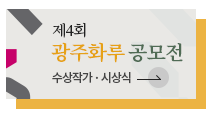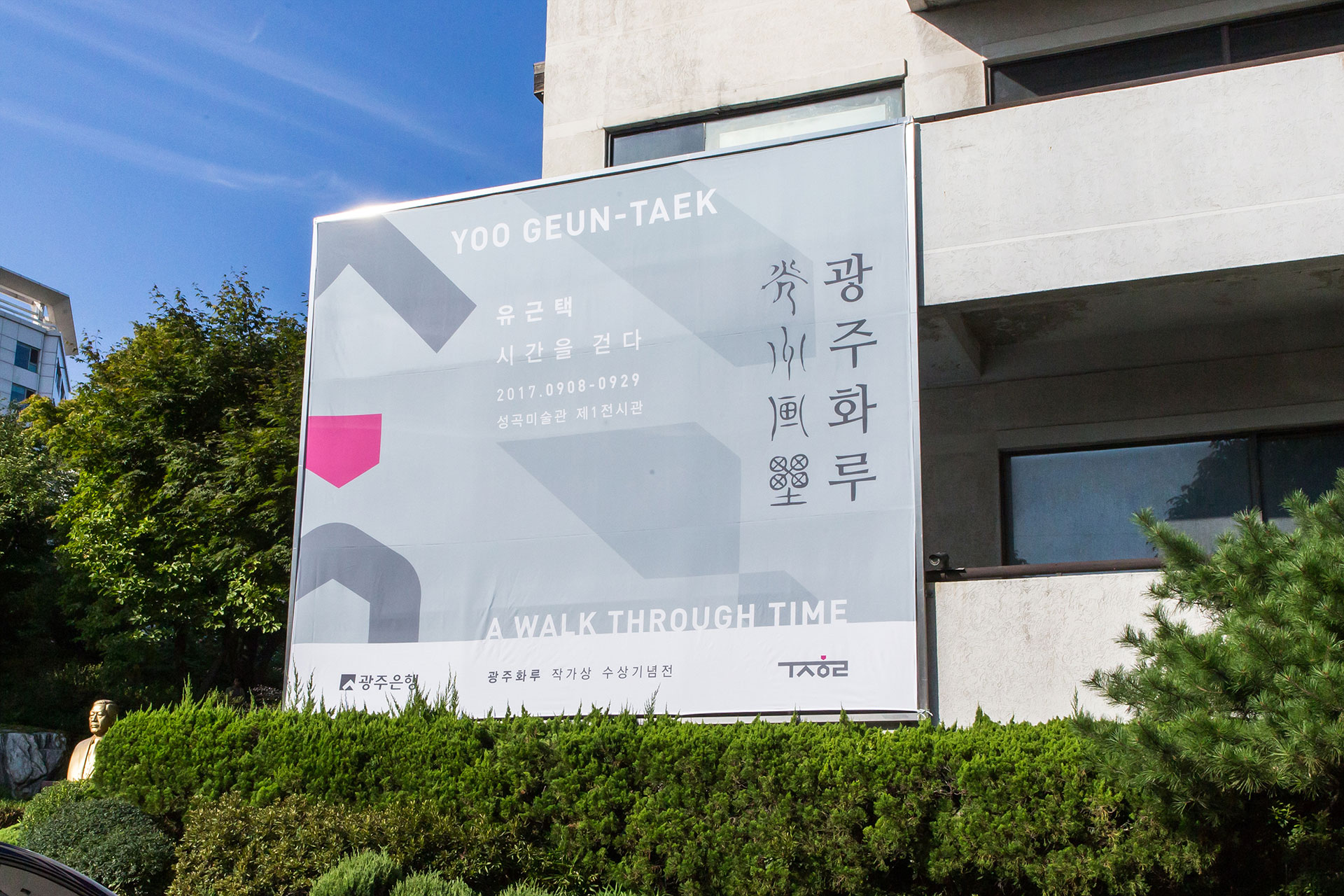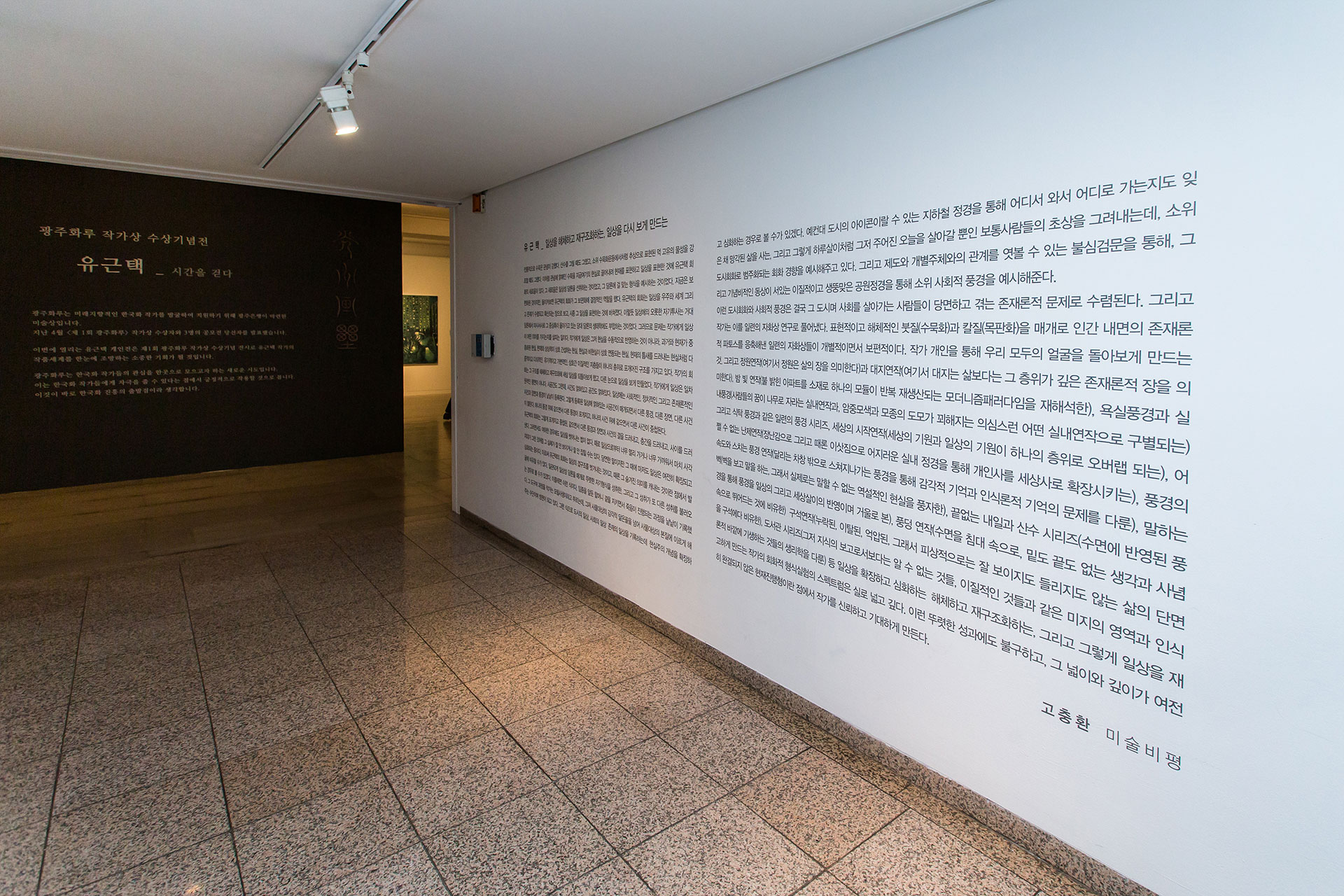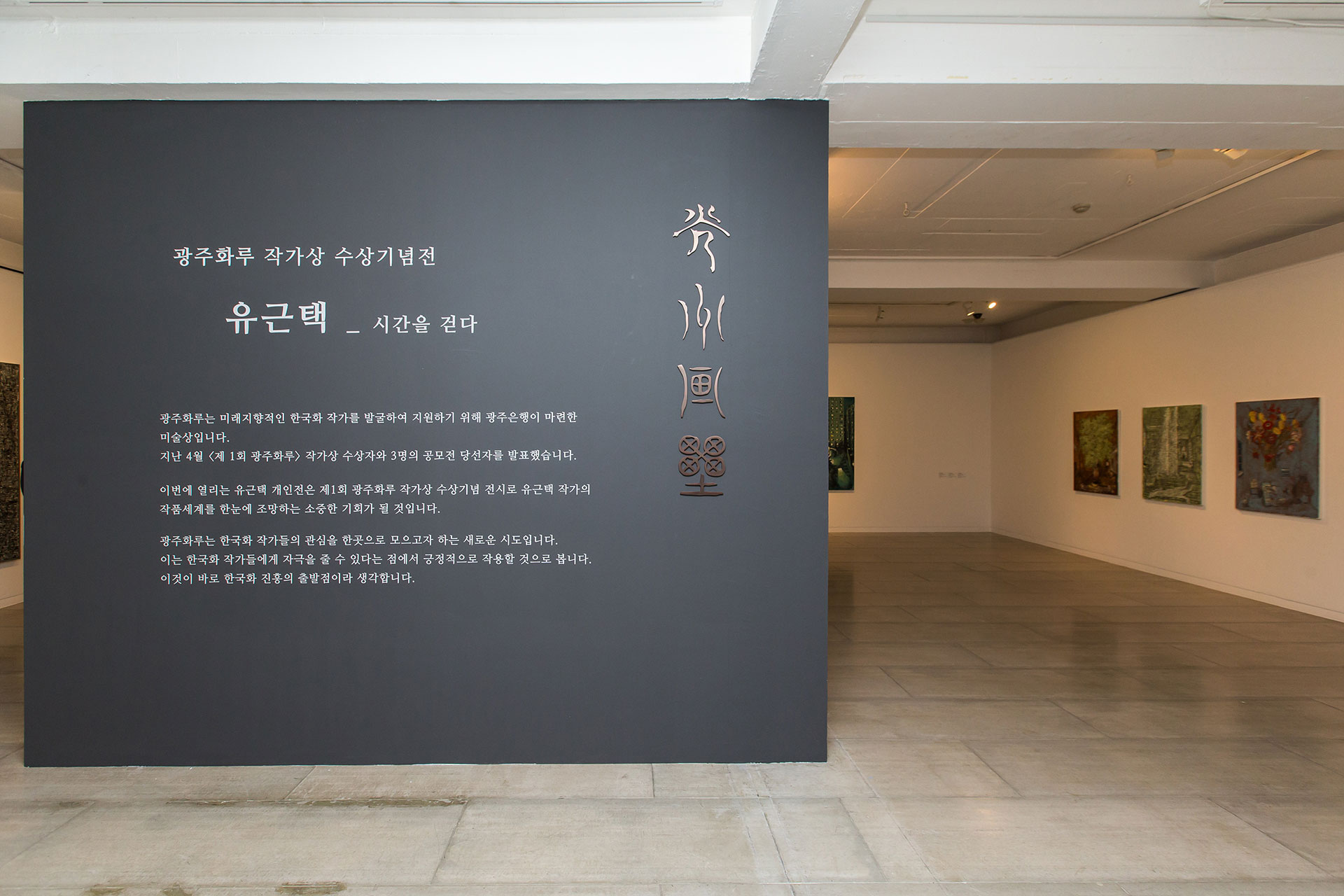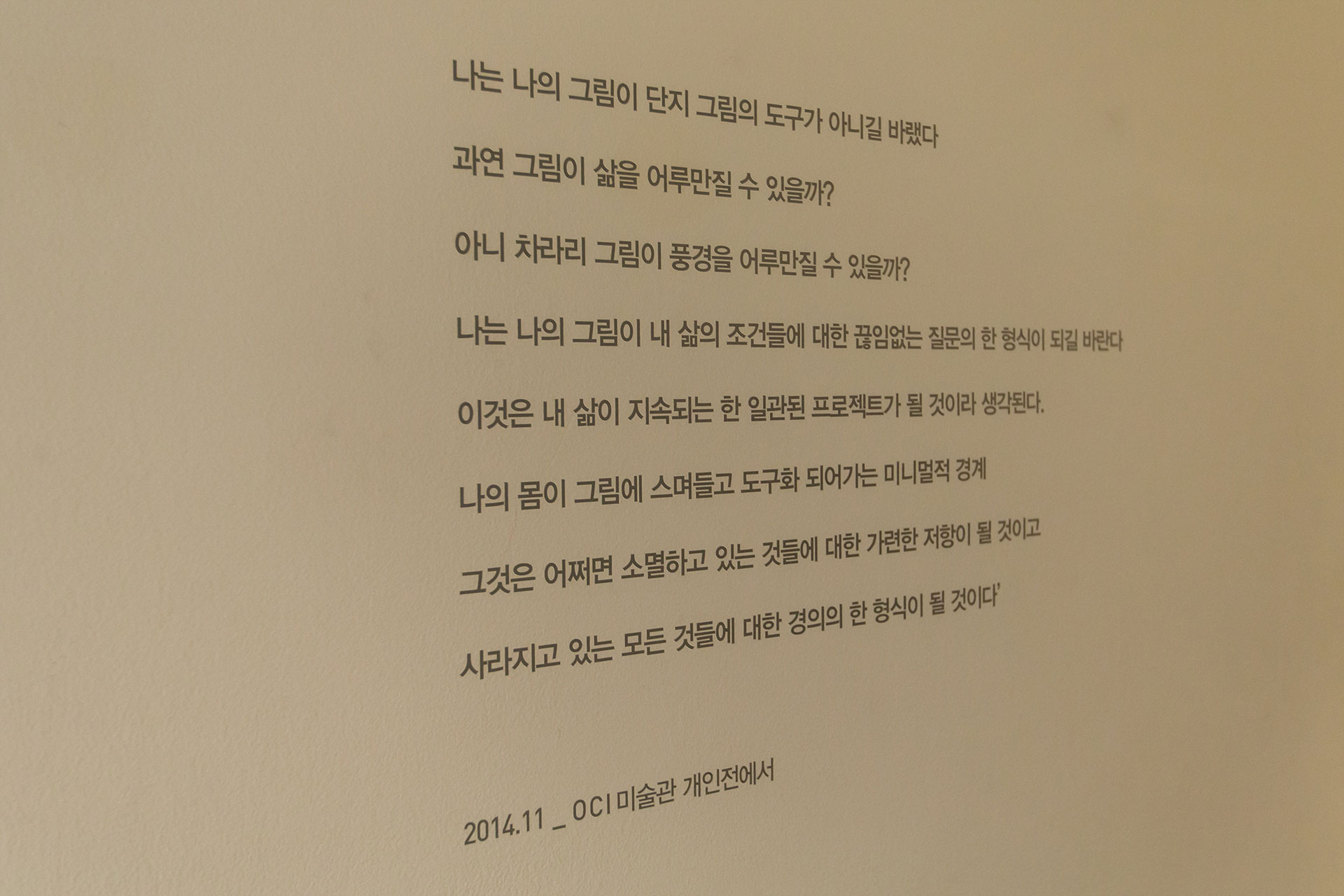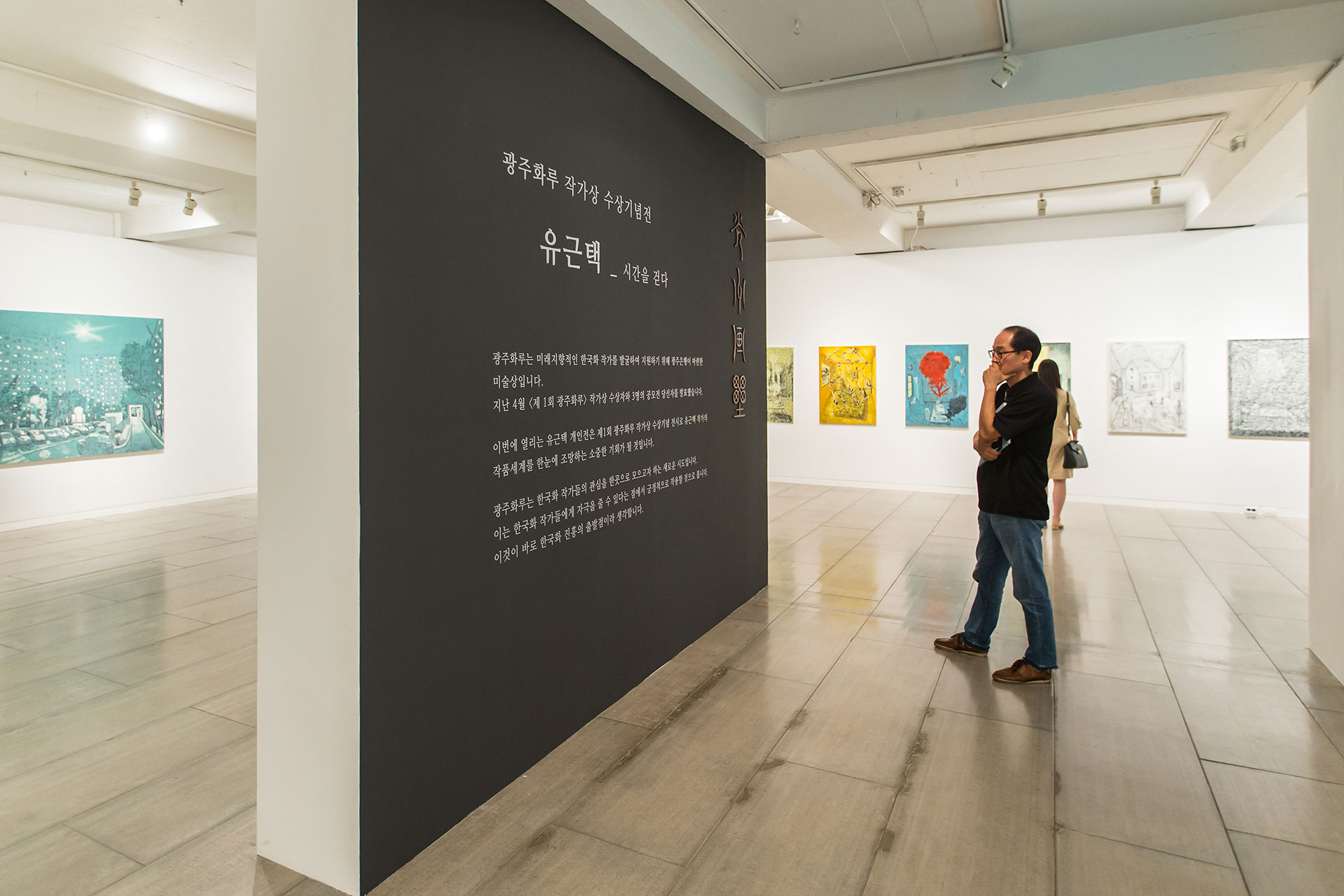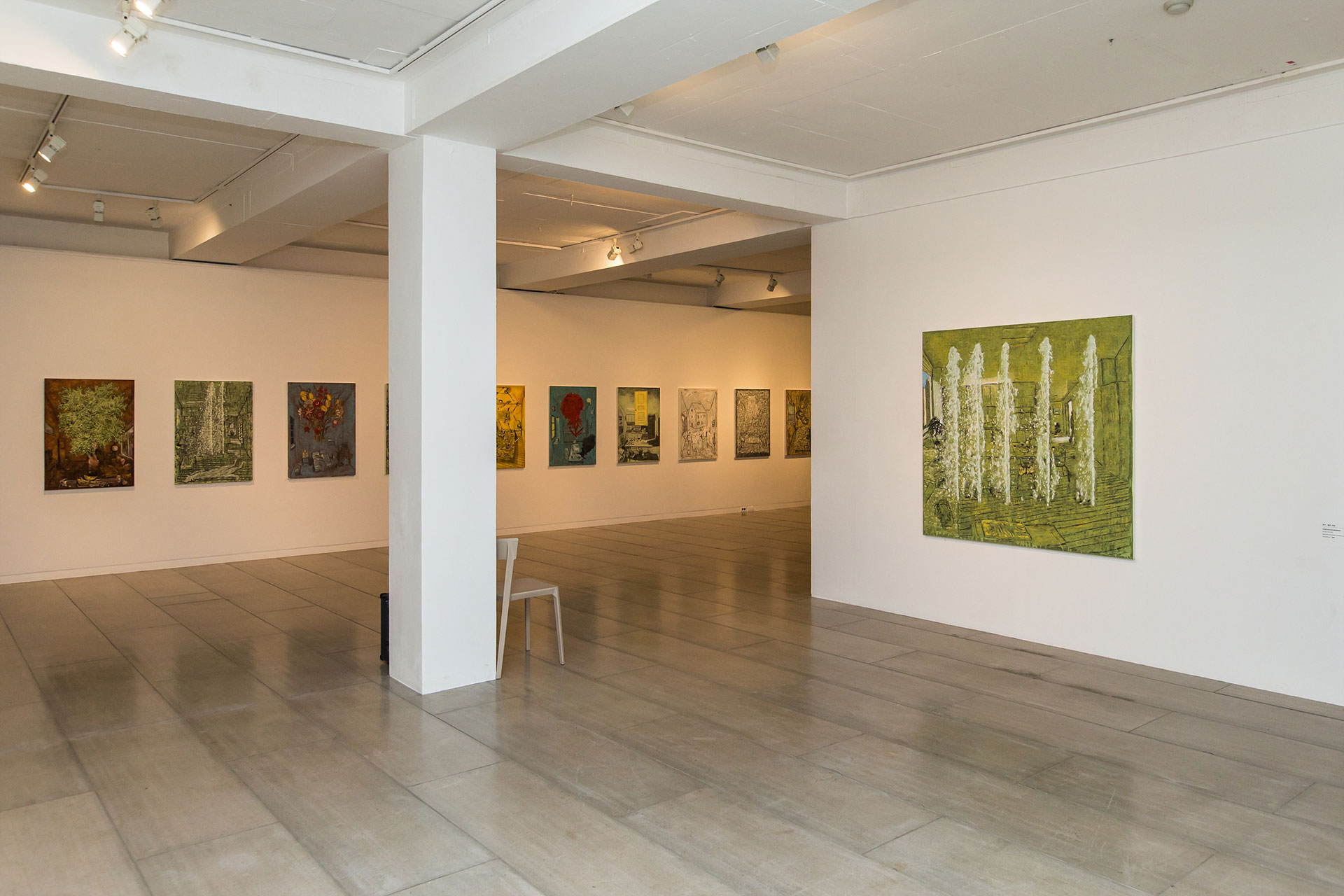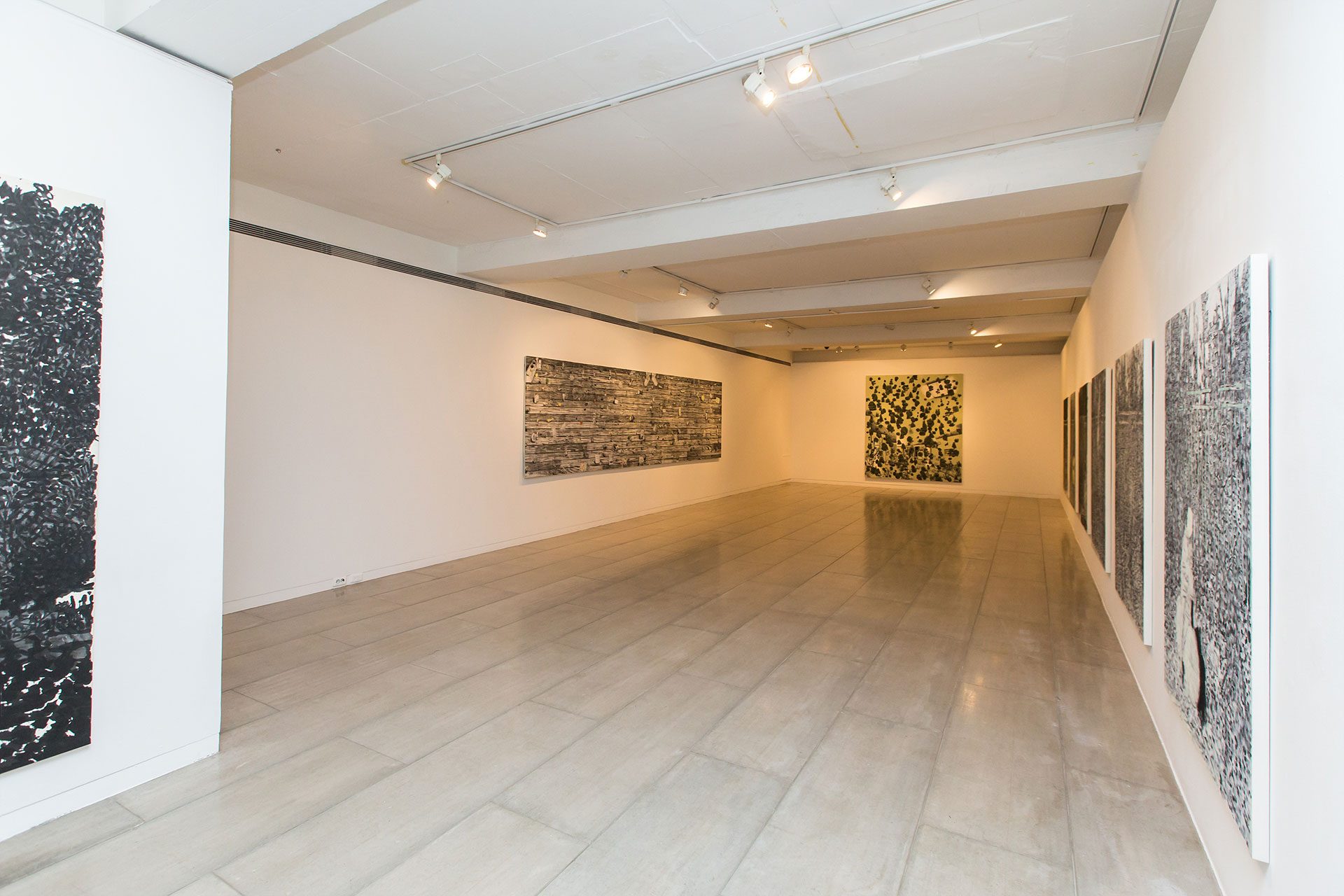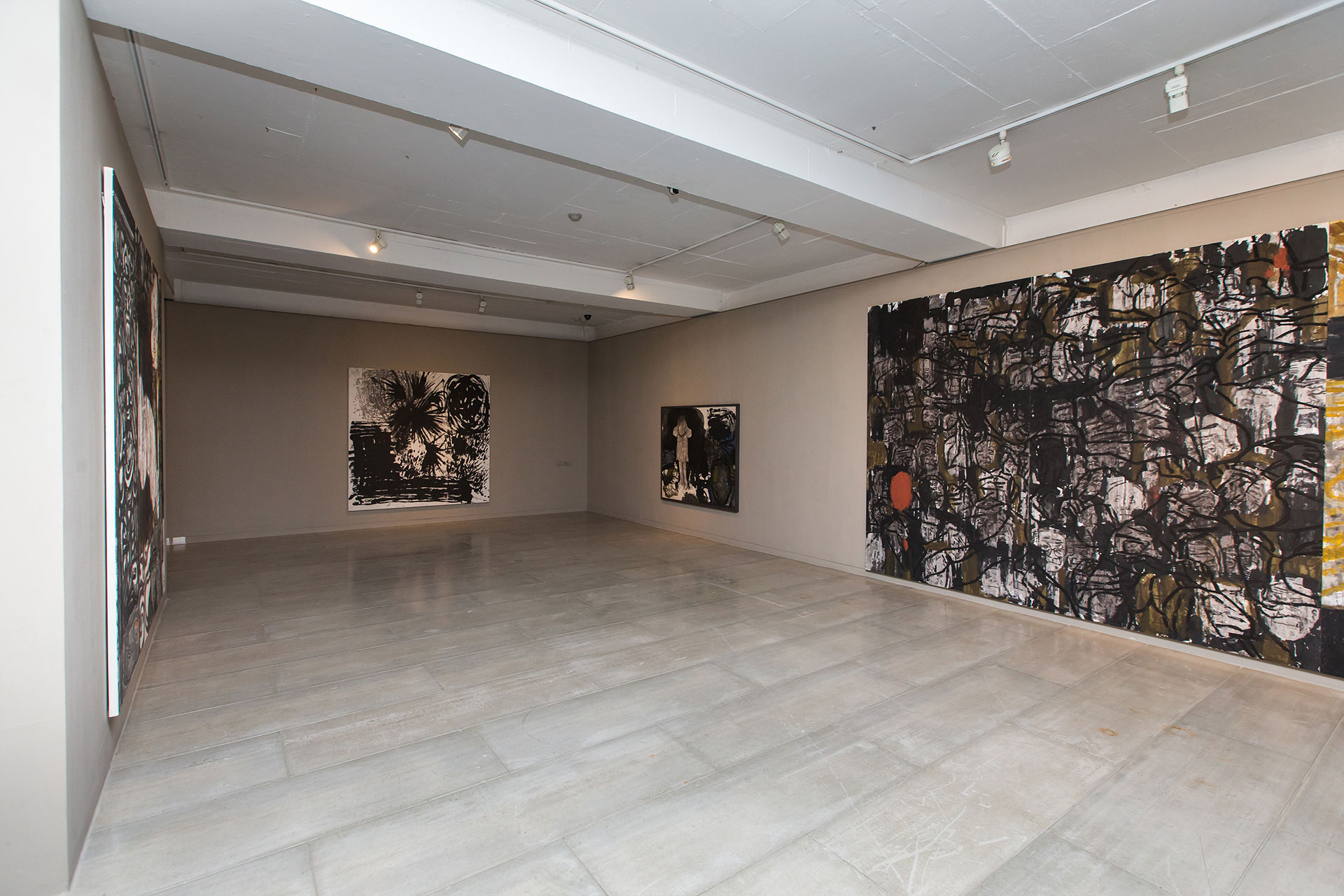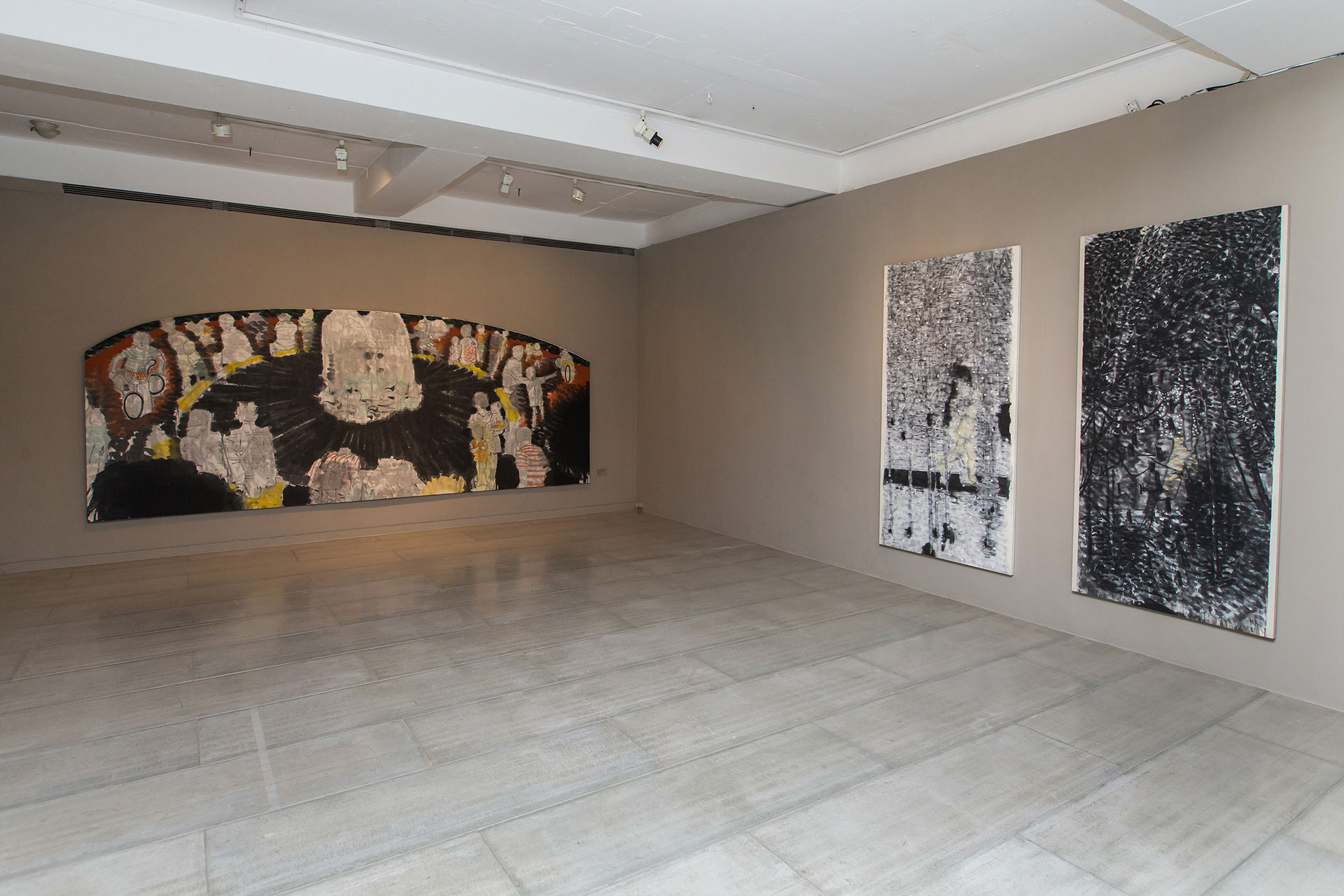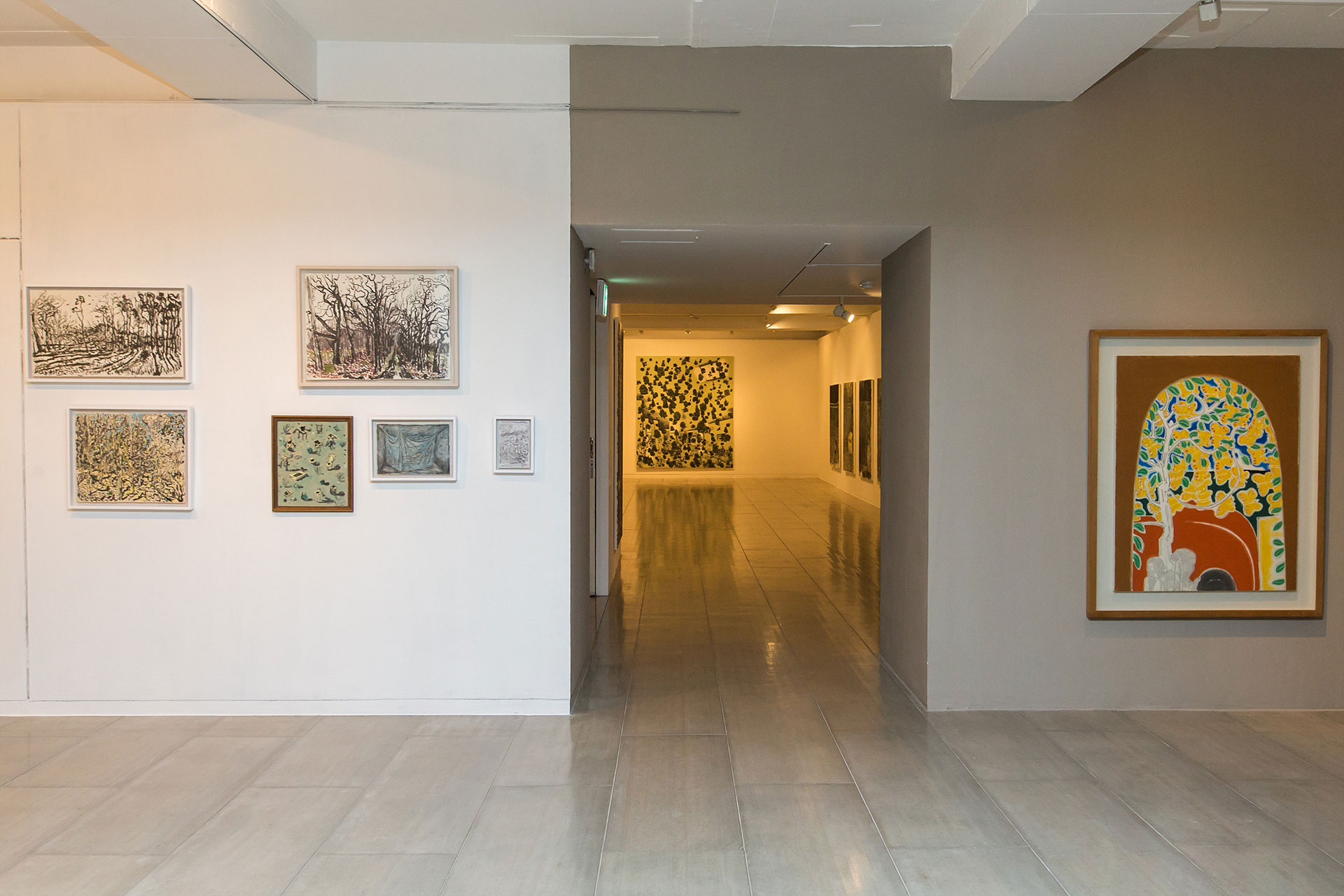작가상

홍익대학교 동양화과 졸업
홍익대학교 대학원 동양화과 졸업
성신여자대학교 동양화과 교수
| 2017 | ⟨어떤 산책⟩, 갤러리현대, 서울 |
| 2016 | ⟨유근택⟩, 21yo-j 갤러리, 일본 도쿄 |
| ⟨유근택 – 소환되는 회화의 전량⟩, 타마미술대학교미술관, 일본 도쿄 | |
| ⟨Breath of Life⟩, 코리아 소사이어티 갤러리, 미국 뉴욕 | |
| ⟨Life on the corner⟩, 신세계갤러리센텀시티, 부산 | |
| 2015 | ⟨끝없는 내일⟩, 포스갤러리, 중국 베이징 |
| ⟨A Passage – 창문 밖을 나선 풍경⟩, 봉산문화회관, 대구 | |
| 2014 | ⟨끝없는 내일⟩, OCI 미술관, 서울 |
| 2013 | ⟨풍·경(風·景) – 유근택의 드로잉⟩, 두가헌갤러리, 서울 |
| 2012 | ⟨하루⟩, 갤러리현대, 서울 |
| 2010 | ⟨유근택⟩, 갤러리분도, 대구 |
| ⟨만유사생(萬有寫生)⟩, 아트사이드갤러리, 중국 베이징 | |
| 2009 | ⟨만유사생(萬有寫生)⟩, 사비나미술관, 서울 |
| ⟨유근택⟩, LA 아트코어 갤러리, 미국 로스앤젤레스 | |
| 2008 | ⟨유근택⟩, 21+Yo 갤러리, 일본 도쿄 |
| 2007 | ⟨삶의 피부 – 나를 구성하고 있는 사선 위의 드로잉들⟩, 동산방화랑, 서울 |
| 2005 | ⟨유근택⟩, 밀레니엄 갤러리, 중국 베이징 |
| ⟨유근택⟩, 21+Yo 갤러리, 일본 도쿄 | |
| 2004 | ⟨장면과 사건 사이, 일상 너머 일탈의 서사⟩, 사비나미술관, 서울 |
| 2003 | ⟨A Scene⟩, 아트포럼 뉴게이트, 서울 |
| ⟨풍경의 속도⟩, 관훈갤러리, 서울 | |
| 2002 | ⟨인물 – 그 내면적 사유: 할머니를 위한 소묘⟩, 갤러리도올, 서울 |
| ⟨유근택⟩, 동산방화랑, 서울 | |
| ⟨동풍⟩, 관훈갤러리, 서울 | |
| 2001 | ⟨유근택⟩, 21+Yo 갤러리, 일본 도쿄 |
| 2000 | ⟨유근택⟩, 제19회 석남미술상 수상작가전, 모란갤러리, 서울 |
| 1999 | ⟨유근택⟩, 원서갤러리, 서울 |
| 1997 | ⟨유근택: Recent Works⟩, 금호미술관, 서울 |
| 1996 | ⟨일상의 힘, 체험이 옮겨질 때⟩, 관훈미술관, 서울 |
| 1994 | ⟨유근택⟩, 금호갤러리, 서울 |
| 1991 | ⟨유근택⟩, 관훈미술관, 서울 |
| 2017 | ⟨페인팅 쇼⟩, 고양아람누리 아람미술관, 고양 |
| ⟨그 집⟩, OCI 미술관, 서울 | |
| 2016 | ⟨자연을 바라보는 시선⟩, 누크갤러리, 서울 |
| ⟨자연, 그 안에 있다⟩, 뮤지엄 산, 원주 | |
| ⟨별별수저⟩, 남서울미술관, 서울 | |
| ⟨사람과 사람 사이⟩, 제주도립미술관, 제주 | |
| 2015 | ⟨나는 불꽃이다, 서울首尔⟩, 63 아트미술관, 서울 |
| ⟨같으면서 다른⟩, 스페이스비엠, 서울 | |
| ⟨표정과 몸짓_소마미술관 소장품⟩, 소마미술관, 서울 | |
| ⟨멈추고, 보다⟩, 국립현대미술관, 과천 | |
| ⟨봄·여름·가을·겨울을 걷다⟩, 서울미술관, 서울 | |
| ⟨한국화의 경계, 한국화의 확장⟩, 문화역서울284, 서울 | |
| ⟨아티스트 포트폴리오 2⟩, 사비나미술관, 서울 | |
| 2014 | ⟨정원⟩, 국립현대미술관, 서울 |
| ⟨사유로서의 형식 – 드로잉의 재발견⟩, 뮤지엄 산, 원주 | |
| ⟨한국현대미술: 우리가 경탄하는 순간들⟩, 산샹당대미술관, 중국 항저우 | |
| ⟨한중 현대미술의 만남⟩, 798아트팩토리, 중국 베이징 | |
| 2013 | ⟨우리, 지금 여기: 오늘의 한국화_자성과 자각⟩, 갤러리 산토리니서울, 서울 |
| ⟨지독한 풍경⟩, 포스갤러리, 중국 베이징 | |
| ⟨신-몽롱주의⟩, 도쿄갤러리, 중국 베이징 | |
| ⟨진경, 眞鏡⟩, OCI 미술관, 서울 | |
| ⟨house & home: 나를 찾다⟩, 제주도립미술관, 제주 | |
| ⟨한국미술, 대항해 시대를 열다!⟩, 부산시립미술관, 부산 | |
| 2012 | ⟨매너와 풍경 – 미술의 생기生氣⟩, 대구예술발전소, 대구 |
| ⟨코리아 투모로우 2012⟩, 예술의전당 한가람미술관, 서울 | |
| ⟨순간의 꽃⟩, OCI 미술관, 서울 | |
| ⟨풍경의 발견⟩, 신세계갤러리, 서울 | |
| ⟨성장⟩, 포스갤러리, 중국 베이징 | |
| ⟨한국의 그림 – 매너에 관하여⟩, 하이트컬렉션, 서울 | |
| 2011 | ⟨조화 – 더 많이, 더 좋게⟩, 갤러리 마음, 미국 뉴욕 |
| ⟨삶과 풍토⟩, 대구미술관, 대구 | |
| ⟨서울, 도시탐색⟩, 서울시립미술관, 서울 | |
| ⟨셀프 카메라: 근대적 자아 자리 바꿔 보기⟩, 성산아트홀, 창원 | |
| 2010 | ⟨21 & Their Times⟩, 금호미술관, 서울 |
| ⟨한국드로잉 30년: 1970-2000⟩, 소마미술관, 서울 | |
| ⟨강진 Celadon Art Project 2010_강진에서 청자를 만나다⟩, 강진청자박물관, 강진 | |
| ⟨프리 스타일: 예술과 디자인의 소통⟩, 홍익대학교 현대미술관, 서울 | |
| ⟨젊은 모색三十⟩, 국립현대미술관, 과천 | |
| 2009 | ⟨예술의 새로운 시작:신호탄⟩, 국립현대미술관, 서울 |
| ⟨Korea on the Rocks⟩, 아트시즌스 갤러리, 스위스 | |
| ⟨크로스 애니메이트⟩, 코리아나미술관, 서울 | |
| 2008 | ⟨정형에 도전한다– 정물, 초상, 풍경⟩, 인터알리아 아트스페이스, 서울 |
| ⟨Form, Idea, Essence and Rhythm: Contemporary East Asian Ink Painting⟩, 타이베이 시립미술관, 대만 타이베이 | |
| ⟨아트인부산2008: 돌아와요 부산항에⟩, 부산시립미술관, 부산 | |
| ⟨봄날은 간다⟩, 광주시립미술관, 광주 | |
| ⟨그림의 대면⟩, 소마미술관, 서울 | |
| 2007 | ⟨비욘드 아트 페스티벌: 미술의 생존과 실존⟩, 대전시립미술관, 대전 |
| ⟨그림 보는 법⟩, 사비나미술관, 서울 | |
| ⟨아시아현대미술프로젝트–City_net Asia 2007⟩, 서울시립미술관, 서울 | |
| ⟨제3회 청두비엔날레⟩, 청두현대미술관, 중국 청두 | |
| ⟨Hommage 100: 한국현대미술 1970-2007⟩, 코리아아트센터, 부산 | |
| ⟨한국화 1953-2007⟩, 서울시립미술관, 서울 | |
| 2006 | ⟨잘 긋기⟩, 소마미술관, 서울 |
| ⟨한∙중 수묵 교류⟩, 의재미술관, 광주 | |
| 2005 | ⟨풍수⟩, 성신여자대학교박물관, 서울 |
| ⟨시대의 초상, 일상의 울림⟩, 박수근미술관, 양구 | |
| ⟨자연을 담은 風景⟩, 충무아트센터 갤러리, 서울 | |
| ⟨한∙중 현대수묵⟩, 서울시립미술관, 서울 | |
| ⟨먹의 바람: 경기도미술관 건립기념 한국화⟩, 경기도미술관, 안산 | |
| 2004 | ⟨한국 모더니즘 미술⟩, 금호미술관, 서울 |
| ⟨울림⟩, 학고재 갤러리, 서울 | |
| ⟨화가와 여행⟩, 서울대학교박물관, 서울 | |
| ⟨작업실 리포트⟩,사비나미술관, 서울 | |
| 2003 | ⟨진경– 그 새로운 제안⟩, 국립현대미술관, 과천 |
| ⟨서울 생활의 발견– 삶의 사각지대를 보라⟩, 쌈지스페이스, 대안공간 루프, 서울 | |
| ⟨물 위를 걷는 사람들⟩, 서울시립미술관, 서울 | |
| ⟨집⟩, 가갤러리, 서울 | |
| ⟨동양화 Paradiso⟩, 포스코미술관, 서울 | |
| ⟨기운 나는 이름, 어머니⟩, 문화일보갤러리, 서울 | |
| ⟨얼굴, 표정⟩, 대전시립미술관, 대전 | |
| ⟨환경미술–물(水)⟩, 서울시립미술관, 서울 | |
| 2002 | ⟨개⟩, 사비나미술관, 서울 |
| ⟨여기, 있음⟩, 인사미술공간, 서울 | |
| 2001 | ⟨수묵의 향기, 수묵의 조형: 한∙중∙일 현대수묵화전⟩, 국립현대미술관, 과천 |
| ⟨내가 만난 사람들⟩, 금산갤러리, 서울 | |
| ⟨2001 오딧세이⟩, 성산아트홀, 창원 | |
| 2000 | ⟨젊은 모색 2000 – 새로운 세기를 향하여⟩, 국립현대미술관, 과천 |
| 1999 | ⟨산수풍경 山·水·風·景⟩, 아트선재미술관, 경주 |
| ⟨한국화의 위상과 전망⟩, 대전시립미술관, 대전 | |
| 1998 | ⟨드로잉의 재발견⟩, 환기미술관, 서울 |
| 1997 | ⟨현대 한국화 5인의 위상⟩, 플러스갤러리, 서울 |
| ⟨21세기 한국미술의 주역⟩, 선화랑, 서울 | |
| 1996 | ⟨한국 모더니즘의 전개 – 근대의 초극⟩, 금호미술관, 서울 |
| ⟨수묵화 운동 이후의 수묵화⟩, 환기미술관, 서울 | |
| ⟨한국 현대미술, 평면회화 주소 찾기⟩, 성곡미술관, 서울 | |
| ⟨오늘의 한국화 – 그 맥락과 전개⟩, 덕원미술관, 서울 | |
| 1995 | ⟨한국 미술 2000년대 주역대표작전⟩, 문화일보갤러리, 서울 |
| ⟨자존의 길 II⟩, 금호갤러리, 서울 | |
| 1994 | ⟨내일에의 제안 – 차세대 시각⟩, 한가람미술관, 서울 |
| 1993 | ⟨우리 미술, 신세대의 방법⟩, 서호갤러리, 서울 |
| 1992 | ⟨오늘의 삶– 오늘의 미술⟩, 금호갤러리, 서울 |
| ⟨92서울현대한국화전⟩, 서울시립미술관, 서울 | |
| 1990 | ⟨인간 모색⟩, 삼정미술관, 서울 |
| 2017 | 제1회 광주화루 작가상, 광주은행, 국립아시아문화전당, 광주 |
| 2009 | 제9회 하종현미술상, 하종현 미술상운영위원회, 서울 |
| 2003 | 2003 오늘의 젊은 예술가상, 문화체육관광부, 서울 |
| 2000 | 제19회 석남미술상, 석남미술문화재단, 서울 |
| 경기도미술관, 안산 | |
| 국립현대미술관, 과천 | |
| 금호미술관, 서울 | |
| 대전시립미술관, 대전 | |
| 리움삼성미술관, 서울 | |
| 모란미술관, 남양주 | |
| 미술은행, 서울 | |
| 부산시립미술관, 부산 | |
| 사비나미술관, 서울 | |
| 서울시립미술관, 서울 | |
| 성곡미술관, 서울 | |
| 성신여자대학교박물관, 서울 | |
| 소마미술관, 서울 | |
| 전등사, 인천 | |
| 중국서안외교관, 중국 | |
| 제주도립미술관, 제주 | |
| 청두현대미술관, 중국 청두 | |
| 하나은행, 서울 | |
| 화이트 래빗 컬렉션, 호주 | |
| OCI 미술관, 서울 |
유근택의 회화
구석의 인문학, 가시적인 것은 비가시적인 것의 부분이다
고충환_ 미술평론가
관념에서 일상으로, 관념적 현실에서 실존적 현실로
수묵화의 장르적 특수성으로 치자면 관념과 물성을 들 수가 있을 것이다. 수묵화의 본질에 해당하는 두 축으로 봐도 되는데, 이 두 축은 서로 다르면서 하나로 통한다. 관념으로 치자면 관념산수를 들 수가 있겠고, 여기에 자연에 귀의하고 사물 대상에 내가 합일되는 정신적 차원이며 경지를 담았다. 그리고 여기에 수묵 고유의 물성이 부합하면서 이런 정신적 경지며 차원에로의 승화를 돕는다. 사물 대상의 정치한 묘사 대신 분위기(다르게는 아우라?)가 강한 질료적 특질이 관념의 형상화에 부응하는 것이다. 그래서 어쩜 전통적으로 수묵화의 행보는 이런 분위기가 강한 질료를 매개로 한 관념의 형상화에 바쳐졌고, 그 기술을 정교하게 발전시켜온 과정이었는지도 모른다. 그래서 그런지 수묵화는 좀체 현실을 표현하거나 일상을 묘사하는 일이 없었다. 모처럼 역사적 현실을 표현하거나 일상적 현상에 주목할 때조차 대개는 신화적 사실(서사?) 또는 설화적 사실에 결부되거나 무속적 사실과 더불어서 각색되는 식이어서 현실과 일상은 여전히 손에 잡히지 않는 실체로 남았다. 말하자면 수묵화는 질료에 대한 형식실험(묵법?)이 됐건 아니면 관념의 표현(자연에의 귀의? 합일?)이 됐건 일상과 현실을 표현하기에는 지나치게 고고한 장르며 형식논리로 남았다.
유근택의 회화가 갖는 가장 결정적인 미덕은 바로 이런 틀을 깨고 수묵화를 현실과 일상으로 내려오게 했고, 이런 현실과 일상을 매개로 지금 여기의 실존적인 차원을 열어놓고 있는 점이다. 그 일은 현실과 일상 자체만으로는 안 된다. 현실과 일상을 해부(해체?)하고 재구성하는 과정을 통해서, 이면 읽기와 행간 읽기를 매개 수행하는 과정을 통해서 현실과 일상의 궁극에 이르고 이를 드러내는 일이다. 다르게는 일시적인 판단중지를 통한 현상학적 에포케를 수행하는 일이다. 관념을 넘어서 현실을 보는 일이며, 관념 없이 현실을 보는 일이다(관념적 현실 곧 현실이라는 관념과 현실 자체는 다르다. 그리고 어쩌면 그 둘 사이에는 아무런 상관이 없다). 감각적(그리고 관념적) 현실을 넘어 진정한 현실(실존적 현실? 그리고 어쩌면 회화적 현실?)을 읽고 보는 일이다. 그저 읽고 본다기보다는 사실은 읽어내고 보아 내는 일이란 점에서 발견이며 발굴을 수행하는 일이다.
그렇게 작가는 죽어가는 할머니를 그렸다. 죽어가는 할머니를 곁에서 지켜보면서 그 진행 과정을 낱낱이 그림으로 기록한 것이다. 그리고 지하철을 이 시대의 아이콘으로 보고 여기에 바로크 시대의 풍속 화가 피터 브뤼겔이 그린 원작 ⟨장님을 인도하는 장님⟩을 패러디해 결부시켰다. 예나 지금이나 시대를 풍자한 그림일 것이다. 작가는 지하철에서 조는 군중의 모습에서 어디로 가는지도 모른 채 그저 갈 뿐인 이 시대의 부조리를, 나아가 인간 실존의 부조리를 보았을 것이다. 여기서 중요한 것은 작가가 가시적인 것이 아닌 비가시적인 것을 그리고, 최소한 비가시적인 것에 관심의 초점이 맞춰져 있다는 사실이다. 이를테면 사람은 누구도 죽음을 볼 수도 알 수도 없다. 다만 주검을 보거나 알 수 있을 뿐. 마찬가지로 장님을 인도하는 장님도(그리고 이에 따른 부조리도) 볼 수도 알 수도 없다. 다만 지하철에서 졸고 있는 군중의 모습을 보거나 알 수 있을 뿐.
그럼에도 정작 작가는 주검(그리고 어쩌면 삶?)을 매개로 죽음을 그리고 있고, 지하철을 매개로 장님을 인도하는 장님으로 나타난 실존적이고 시대적인 부조리를 그리고 있다. 적어도 그림의 주제로 유추해볼 때 그렇다. 가시적인 것을 매개로 비가시적인 것을 보고, 감각적 현실을 통해 실존적 현실을 읽어내는 것이다. 여기서 가시적인 것은 비가시적인 것이 출몰하는 계기가 되고, 감각적 현실은 실존적 현실이 드러나 보이는 매개가 된다. 조르조 아감벤이 아리스토텔레스를 인용해 유령이라고 부른 것이다(아리스토텔레스는 비가시적인 것을 유령이라고 부른다). 슬라보예 지젝이 자크 라캉을 인용해 실재계라고 부른 것이다(라캉은 억압된 현실을 실재계라고 부른다). 그리고 어쩌면 아방가르드의 낯설게 하기 혹은 소외 효과 혹은 소격 효과도, 그렇게 작가는 비가시적인 것이 출몰하는 계기로서의 가시적인 것, 실존적 현실이 드러나 보이는 매개로서의 감각적 현실에 관심이 많다. 가시적인 것을 더 깊이 보고, 감각적 현실을 꿰뚫어 보는 것이다. 그렇게 보면 안 보이던 것이 보이고, 억압된 현실이 드러나 보인다. 인문학적 상상력이 뒷받침되지 않으면 어려운 일이다.
그렇게 작가는 꼬마가 어질러놓은 장난감과 이삿짐으로 어수선한 실내 정경에서, 그리고 미처 풀지 못한 짐꾸러미가 생경한 여행지의 외진 방에서 세계의 축소판을 본다. 보기에 따라선 ⟨어쩔 수 없는 난제들⟩이라는 큰 제목으로 묶여질 이 일련의 그림들에서 작가는 정치적 현실의 그리고 삶의 알레고리를 본다. 삶이란 정처 없이 떠도는 것이고, 부유하는 것이고, 매번 새롭게 주어지는 어쩔 수 없는 난제들에 봉착하는 일이고, 그 난제들과 더불어서 사는 일이다. 짧은 설렘과 긴 진부함과 더불어서 사는 일이다. 부유하는 삶이고 부박한 삶이다. 도대체 이 삶에는 뿌리내릴 수도 한 군데 정박할 수도 없다. 문제들은 해결된 것 같지만 여전히 미봉책인 채로 남겨지고, 계획과 필연이 삶을 지배하는 것 같지만 큰 틀에서 보면 '저절로'와 '우연'이 하는 일이다.
그렇게 작가의 그림엔 유독 부유하는, 공중에 붕붕 떠다니는 사물과 정경을 그린 그림들이 많다. 소시민적 삶이 물을 주고 가꾼 꿈나무들이 떠다니고, 이국적으로 설레는 꽃다발이 떠다니고(파스텔 톤으로 그린 르동의 몽환적인 꽃? 아파트 위로 피어오르는 불꽃놀이?), 미처 내뱉지 못한 속말들이 떠다니고, 잡다한 생각의 편린들이 떠다니고, 이런저런 번민들이 떠다닌다. 그렇게 떠다니면서 실내의 정경은 포화되고 그림 너머로까지 넘쳐난다. 감각적 현실과 관념적 현실이 하나의 화면 속에 포개져 있다는 점에서 일종의 이중 그림 혹은 다중 그림으로 볼 수 있겠다. 소설로 치자면 두 개 이상의 서로 다른 내러티브가 동시에 진행되는 액자소설로 볼 수도 있겠다. 형식적으로나 의미론적으로 그림의 용량을 확장시키고 증폭시키는 경우로 볼 수 있겠고, 감각적 현실을 통해 억압된 현실이며 실존적 현실(이를테면 미처 못다 한 말들을 드러내 보이는 경우)로 볼 수 있겠고, 유령과 실재계를 불현듯 출몰시키는 미학적 장치로 볼 수 있겠다.
그렇게 떠다니는 것 중에 문이 있고 망루가 있다. 그 문을 열고 들어서면 같은 듯 다른, 얼핏 언제나 그렇듯 그 모습 그대로의 일상이라는 세계가 거기에 있다. 때로 발을 잘못 디디면 추락할 수도 있는, 그리고 공중에 붕 뜬 망루는 이중적이고 다중적이다. 지금 여기가 아닌 저기 저곳을 향한 이상주의를 지향하면서, 동시에 그 이상주의는 현실에 정박하지 못한 채 부유하고 있다. 부유하는 이상? 떠도는 경계? 경계와 감시? 자기검열? 아마도 어느 정도 이 모두를 의미하고 함축할 것이다.
그렇게 비가시적이면서 가시적인 것, 잘 안 보이지만 잘 보면 보이는 것 중에 불심검문이 있다. 작가의 그림에서 불심검문은 고도로 제도화된 사회며 일상에 대한, 그리고 그 일상을 사는 개별 주체와 제도와의 관계에 대한 알레고리처럼 읽힌다. 모든 사람은 제도적 주체들이며, 따라서 제도는 그 주체들의 가능하거나 예상되는 일탈을 감시하고 감독할 수 있는 정당한 권리를 가진다. 작가의 불심검문 그림은 말하자면 권력 담론을 매개로 제도와 개별 주체와의 관계를 밝힌 미셀 푸코를 떠올리게 한다. 그리고 제도와 권력 앞에서 벌거벗은 인간을 의미하는 아감벤의 호모 사케르를 떠올리게 만든다.
이런 일상을 그린, 일상적 현실을 실존적 현실로까지 확장하고 심화해 그린 일련의 그림들의 중심에 자화상이 있다. 일상을 살고 실존적 현실을 사는 주체로서의 자의식이 반영된 자연스런 결과로 볼 수도 있겠지만, 그럼에도 여하튼 작가의 경우에는 유독 자화상이 많은 편이다. 자기 반영성이 강한 경우로 볼 수 있겠고, 그 경향이 굳이 자화상이 아닌 다른 그림들에도 그대로 반영되고 스며든 경우로 볼 수가 있겠다. 그런데 그 자화상이란 것이 하나같이 예사롭지가 않다. 한눈에도 액션페인팅, 우리말로는 소위 몸 그림을 연상시키는, 내적 파토스를 가감 없이 분출시켜 그린 격렬한 그림들이다. 지우고 그리기를 무수히 반복해 그린, 자기 부정과 자기 긍정의 이율배반적인 과정이 하나의 층위로 중첩되고 점철된 치열한 그림들이다.
헤겔 식으론 부정을 통해 긍정을 얻는 지양에 해당하고, 좀 거창하게 말하자면 불교에서의 진아를 찾는 지난한 여정에 해당한다. 롤랑 바르트의 너덜너덜해진 양피지 이론과도 무관하지가 않은데, 옛날 양피지가 종이를 대신하던 시절 너무 많이 고쳐 쓴 나머지 너덜너덜해진 양피지에 고스란히 기술된(실제로는 흔적으로 남은) 긍정과 부정의 우연하고 무분별한 총체가 그렇다. 그렇게 나, 자아, 주체, 에고의 실체는 쉽게 붙잡히지가 않는다. 그래서 작가는 이번에는 목판에다가 아예 칼로 헤집고 들쑤시고 난장을 치는 방법을 택한다. 붓을 칼처럼 칼을 붓처럼 휘둘러 붙잡히지 않는 실체를 붙잡으려는 무모한 행보를 보여준다. 그렇게 작가는 마침내 실체를 붙잡았는가. 진정한 자기와 마주했는가. 단정할 수는 없는 일이지만, 적어도 작가가 그리고 파낸 일련의 자화상들에는 그 지난한 흔적이며 치열했던 과정이 낭자하다.
그런가 하면 작가의 자화상은 일종의 신화소의 형태(그 완전한 형태로 치자면 물과 불과 흙과 공기의 4 원소)로 옮겨가기도 한다(신화소를 주체의 근원과 결부시키는 것은 카발라 사상과 관련이 깊다). 물과 불이 그것인데, 특히 물이 그렇다. 작가의 그림에서 작가를 대리하는 신화소 중 불이 들불과 연기의 형태로 가끔씩 나타나는 것에 비해 보면, 작가의 그림에는 유독 물을 그린 그림들이 많다. 분수가 그렇고, 풍경을 반영하고 관념을 반영하는, 그래서 차라리 의식의 무감한 흐름을 보여주는 호수가 그렇고, 홍수 또는 세계의 기원을 그린, 차라리 매 순간 갱신되는 일상의 기원을 그린 소용돌이(휘몰이)가 그렇다. 그리고 물은 심지어 잠을 자기 위한 침대에마저 나타난다. 이불보의 자연스런 구김새와 산맥의 주름, 그리고 물보라마저 이는 파도가 오버랩된 침대 속으로 풍덩하고 빠져드는 것인데, 뒤척이는 잠과 잠 못 이루는 밤을 표현한 것이고, 아마도 잠을 내면으로의 여행에 비유한 몽상적인 해석의 경우로 볼 수가 있을 것이다.
이 일련의 물 그림들에서 물은 말할 것도 없이 자기를 반영하는 거울에 해당하고, 그 거울은 인류 최초로 자기를 반영한 나르시스의 물거울을 계승한 것이다. 그렇게 작가는 자기를 그리고, 일상을 그리고, 실존적 현실을 그린다. 그리고 그렇게 수묵화의 관념적 현실을 회화적 현실(그림 속에서, 그림을 통해 비로소 실체를 얻는 현실. 그러므로 어쩌면 현실을 확장하는 현실)로 확장하고 심화한다.
구석의 인문학, 가시적인 것은 비가시적인 것의 부분이다.
여기에 구석이 있다. 구석은 작가가 실제로 특정해 그린 소주제이기도 하지만, 보기에 따라서 작가의 전작을 관통하는, 작가가 세계를 보고 그림을 대하는 관점이며 태도를 지지하는 전제로 볼 수 있다. 작가의 작업은 말하자면 구석이라는 개념으로 묶일 수 있고, 그런 만큼 구석이라는 개념을 프리즘 삼아 작가의 작업을 읽을 수도 있다는 말이다. 여기서 구석은 무엇보다도 장소적 개념이고 공간적 개념이다. 그건 분명 장소며 공간이지만 잘 보이지도 인식되지도 않는, 장소 속 비장소이며 공간 속 비공간이다. 여기서 구석은 장소적 개념이며 공간적 개념을 넘어 인식론적 개념으로 확장된다. 즉 인식론적으로 구석은 인식론의 그물에 걸리지 않는, 그럼에도 여전히 인식론의 대상인 채로 남아있는 존재와 존재방식을 의미한다.
무슨 말이냐고 하겠지만, 인식할 수 없는 대상, 인식할 수 없지만 엄연히 존재하는 세계가 있다. 모리스 블랑쇼를 인용하자면 인식론적 바깥, 인식론 안의 바깥이 존재한다. 시야의 범주 안에 있으면서 감각이 미치지 못하는 영역을 사각지대라고 하는데, 그 감각적 한계를 인식론적 한계로 대치하고 확장한 경우를 생각해보면 되겠다. 미셀 푸코의 헤테로토피아(초장소)도 그렇다. 사람들의 머릿속에만 존재하는, 실제로는 존재하지 않는 장소를 유토피아라고 한다. 유토피아를 이상 세계라고 부르는 이유가 여기에 있다. 바로 이상으로만 존재하는 세계다. 이에 반해 헤테로토피아는 분명 존재하지만 정작 사람들의 의식 속에서 지워진 장소를 의미한다. 푸코는 군대, 감옥, 정신병원, 휴양지(그 목록은 사실상 무한하며, 최근의 사례로는 가상현실과 특히 SNS를 여기에 포함시키기도 한다)를 그 예로 들고 있는데, 여기선 억압의 계기들이 돌파구를 찾지 못한 채 차곡차곡 쟁여지기만 하기 때문에 사회와 제도의 입장에서 볼 때 위험요소며 잠재적인 혁명의 계기가 된다. 자크 라캉의 실재계(억압된 현실의 계)와 쾌락 원칙(자기를 실현하려는 욕망)과 오브제 아(여하한 경우에도 대상화되지 않은 채로 남아있는 불가지)도 그렇다. 그리고 여기에 아리스토텔레스가 비가시적인 것을 부르는 유령에 이르기까지.
작가의 작업에서 구석은 알 수 없는 모종의 일들이 도모되는, 일탈적 행위가 도모되는 의식 작용을 구석의 공간적 개념에 빗대어 표현한 것인데, 특히 서재가 그렇고 샤워가 그렇다. 각각 독서와 휴식의 계기를 내세운 것이지만, 사실은 그 이면에서 세계를 읽는 일과 철저하게 혼자인 시간을 표현한 것이다. 보기에 따라서 독서와 휴식은 반사회적이고 반제도적인 행위이며 계기일 수 있다. 그런가 하면 인식론적으로 구석은 비가시적인 것을 의미하기도 한다. 이를테면 ⟨어떤 만찬⟩은 표면적으로 선남선녀들의 만찬이고 말들의 성찬이지만, 잘 보면 그 이면에 도사리고 있는 이해관계가 보인다. 이런 비가시적 실체며 은폐된 실체를 드러내고 폭로하는 것이 아니라면 작가의 만찬 그림은 아무 것도 아니다. 정치적 담론을 주제화한 것인데, 또 다른 경우로는 근작에서의 핵을 매개로 한 6자 회담의 주체들을 테이블 가장자리에 내세운(내몬?) 그림이 있다. 여기서 가장자리는 또 다른 구석이고 바깥에 해당한다. 그렇게 삶은 언제나 가장자리(아니면 구석)로 내몰리는 삶이며 위태로운 삶이다. 그러므로 작가의 작업에서 구석은 그리고 가장자리는 위태로운(어쩌면 불안정한) 삶의 알레고리처럼 읽힌다.
구석 자체는 장소적 개념이고 공간적 개념이지만, 그건 무엇보다도 의식 작용(특히 반사회적이고 반제도적인)을 빗대어 표현한 것일 수 있다고 했다. 공원, 정원, 울타리, 그리고 산책을 주제화한 일련의 그림들이 이처럼 장소적이고 공간적인 개념을 빌린 의식 작용을 표현한 것들이다. 이를테면 표면적으로 공원은 휴식을 위한 공간이지만, 때로 이데올로기적인 장소(모든 공원에는 어김없이 기념비적인 동상이 하나쯤 있다), 일탈이 도모되고 불량이 움트는 장소, 의심스러운 장소일 수 있다. 그리고 정원은 실제적인 장소로서 보다는 마음의 정원을 의미하며, 사유의 유목을 의미한다. 그 핵심 개념이 산책이다.
보들레르와 발터 벤야민에게 산책은 만보가 즉 아무런 목적 없이 어슬렁거리고 기웃거리면서 걷는 사람의 의식 상태를 의미하고, 우리 식으론 소요유가 여기에 근사한 의미를 가지고 있다. 아무런 목적이 없다는 점이 공통점이고, 그 자체로 반사회적이고 반제도적이란 점이 공통점이다. 그러나 여기서 목적 없음은 결정적인 미학적 덕목이기도 하다. 즉 전제된 의식, 사전에 결정화된 의식이 아닌 열린 의식을 의미한다. 그렇게 열린 의식과 더불어 산책을 할 때면 몸도 산책을 하고, 감각도 산책을 하고, 물론 의식도 산책을 한다. 바람과 대기와 공기의 질감처럼 그 존재방식이 모호한 것들도 산책을 하고, 걷잡을 데 없이 흐르는 생각처럼 잡다한 것들도 산책을 한다. 모호한 것들, 잡다한 것들, 그러므로 어쩌면 비가시적인 것들, 유령들도 산책을 한다.
작가는 산책을 하면서 이 모든 것들이 출몰하는 것을 보고 그리고 영상으로 옮긴다. 영상도 그렇지만 때로 작가의 그림은 배경과 모티브를 분리하는 것이 불가능할 정도로 일체화된 것처럼 보이고, 모티브가 배경의 일부처럼 보이고, 배경으로부터 모티브가 불 듯 출몰하는 것처럼도 보인다. 산책의 경우 배경은 숲 아니면 나무이기 쉬운데, 숲 사이로 아니면 나무 뒤편에서 모티브(공기의 질감? 흐르는 생각? 의식으로 환원되지 않는 감각적인 경험? 숲의 비의? 숲의 순례?)가 스미는 것처럼도 보이고 배어 나오는 것처럼도 보인다. 비가시적인 것을 가시적인 것 위로 밀어 올리는 것인데, 그림으로 인해 비로소 그 실체를 얻는 회화적 사실 혹은 회화적 현실이 열리는 순간이며 사건으로 볼 수가 있겠다.
그러므로 작가에게 산책은 무엇보다도 유목을 의미하며, 사유의 유목을 의미한다. 그저 풍경이고 사물 대상을 그린 것이 아니라, 유목하는 과정에서 사유된 것들이 거꾸로 풍경을 흔들고 사물 대상을 간섭하는, 그런, 물과 아(주체)가 상호작용하는 사건이며 장을 열어놓는 그림들이다. 다시, 그러므로 작가에게 회화는 세상을 산책하고 사유하는 일이며, 인식론적 구석을 탐색하는 일이다. 의미화되지 않는 것들, 의미화를 거부하는 것들, 양가적인 것들, 인식론의 그물에 포획되지는 않으면서 다만 감각되는 것들, 인식론(그리고 어쩌면 인식?)의 균열과 틈새를 탐사하는 일이다. 그 탐색과 탐사는 현재 진행형이며, 이로 인해 한국화는 또 다른 지평을 열게 될 것이다. 어쩌면 이미 열어놓고 있다.
Humanities of Corner ; the visible is the part of the invisible
Kho, Chung-Hwan_Art Critic
From ideas to daily lives from ideal reality to existential reality Speaking of specificities of ink-wash-painting as genre, idealism and materiality can be counted. While these two are considered as two essential pillars of ink-wash-painting tradition, these two are different nevertheless point one thing at the same time. Speaking of ideas, there is ideal landscaping tradition in Korean painting in which painting conveys spiritual dimension after returning to the nature and being in unison with thing objects. Furthermore, when innate materiality of ink-wash-painting is in accordance with idea, a painting can be transcended to such dimension. It is the way of distinct atmospheric (in other word, aura?) nature as the matter to response to materialization of idea instead of detailed and elaborate description of thing objects. The direction of ink-wash-painting to dedicate to materialization of ideas mediated by matters with strong aura has been tradition and its course of ink-wash-painting might have been that of developing accordant methodologies. This might have contributed to its custom that rarely focuses on expressing reality or describing daily lives. Even in the rare occasions that depicted historical events or paid attention to phenomena in life, artists only related to mythical facts (narrative?) or fairy tales or only adapted superstitious element so that reality and daily lives remained still an intangible mystery. No matter it was the formal (principal?) experimentation of the essence or the expression of ideas, it remained as genre and style too detached to express reality or daily lives, so to speak.
The most critical virtue in Yoo Geuntaek's art lies in the fact that he broke out of such framework by bringing ink-wash-painting practice down to the realm of reality and daily lives. Using this reality and daily lives as medium, he opens up existential dimension. Such action is not as simple as just taking them as subject matter. It involves with reaching to ultimatum of reality and daily lives and revealing them through the process of dissection (deconstruction?) and reconstruction of reality and daily lives and through performance and mediation of reading the other side and between the lines. In other words, it is to perform a phenomenological epoche through temporal suspension of judgment. This also means to see the reality beyond ideas and to see the reality without ideas. (The idea that ideological reality is the same as reality is not the same as the reality itself. These two might have nothing to with each other.) It is to go beyond sensible (and ideological) reality and to read and see true reality (existential reality?) To achieve to read out and see rather than just reading and seeing are the acts of discovery and excavation.
Like that, the artist depicted an old lady dying. He watched a dying old lady next to her deathbed and documented minutiae of the process onto his paintings. Also, he took subway as icon of the time to connect to genre painter, Peter Breugel's
Despite all, the artist chose to depict death with the body (or life?) as medium and depicted absurdity of the time existence shown through the blind leading the blind with subway as medium. None the least, it is if one analyzed their subjects. He sees the invisible through the visible as medium, and reads existential reality through sensible reality. Here, the visible works as cause that allows the invisible to emerge and sensible reality becomes mediator to reveal existential reality. Georgio Agamben once called this a ghost quoting Aristotle. (Aristotle called the invisible a ghost.) This is what Slavoj Žižek called the real referring to Jacques Lacan. (Lacan referred repressed reality the realm of the real.) We may include avant-garde idea of distancing effect, alienating effect, or estrangement effect in this. As such, the artist has shown interests in the visible that give a rise to appearance of the invisible, sensible reality as a medium for revealing existential reality. He sees the visible more carefully and sees through sensible reality. Then he can achieve to see things that have been invisible, and the reality that was repressed. This cannot be accomplished without support from imagination based on humanities.
Just like that, the artist sees the microcosm of the world from the interior with piles of toys a child scattered and sees miniature of the world from a remote room with disarray of unpacked luggage in foreign places he traveled to. From these series of paintings which can be categorized under the title
Among the floating things like that, there are door and watchtower. Once you enter the door, there lies same but different world called daily life seemingly the same as it was always. The watchtower hovering in the air, from which you may fall if you take a false step, is dualistic and multi layered. Pursuing idealism by looking at the direction of not here and now but there, an idealist drifts without being able to harbor in the real world at the same time. Floating ideal? Wandering boundaries? Borders and surveillance? Self-censorship? It might mean and imply all of the above to some extent.
Like that, there comes the police questioning amongst the visible but invisible, barely visible if look carefully. In the artist paintings, police questioning can be read as an allegory for the highly institutionalized society and daily lives and the relationship between institutions and individual subject who is living daily lives. All men are the subjects of institutions so that institutions have rightful authority to watch over and direct the subjects' possible and predictable deviations. His painting of police questioning reminds me of Michel Foucault who disclosed relationship between individual subject and institutions using power discourses as medium. It also reminds me of Agamben's Homo Sacre, naked human beings in the face of power and institutions.
In the center of the series of paintings that deepened and expanded daily life to existential reality, there lies the artist's self-portrait. Though this can be read as a reflection of his self-consciousness as the subject who lives daily life and existential reality, nonetheless one cannot help but to notice there are so many self-portraits in his oeuvre. This can be read that he has strong tendency of expressing himself and such tendency has permeated into other series of art works rather than self-portraits. On the other hand, all his self portraits are quite intriguing. Even at the first glance, one can see they are so powerful reminding us of Action Painting, a painting technique involves whole body and rush of inner pathos without reservation or exaggeration. They are fierce painting created through repetition of painting and erasing, antimonial processes of self-assurance and self-negation are overlapped and concentrated on one picture plane.
This is relevant to Hegelian sublation through which one attains positivity though negation. If I may exaggerate, this can refer to the impossible journey with which one pursues one's true self. This is not unrelated to Roland Barthes' theory on rugged parchment. According to him, one can find that coincidental and irrational whole of self-assurance and self-negation is documented (left as traces) on rugged parchment because it was written and reused over and over when such parchment was used before the invention of paper. Like that, it is not easy to capture the reality of who I am, self-hood, subjectiveness, or ego. Thus the artist chose to beat himself up by even digging up and ransacking wood blocks with woodcut knife. He showed reckless gesture to capture the real he cannot apprehend by swinging brushes like a knife and swinging knifes like a brush. Did the artist finally get a hold of the real, like that? Did he face with his true self? It is hard to make a conclusion. Nonetheless, his paintings and woodcuts of self-portraits are covered with traces of most difficult time and fierce process.
On the other hand, the artist's self-portraits also move on to the form of mytheme (Connecting mytheme with the origin of the subject is related to Kabbalah. Whole form of mytheme would be four elements: water, fire, earth, air). Water and fire is the ones in his paintings. And water in particular is more so. Among the mythemes that represents the artist himself, fire can be found in the forms of wild fire or smoke at some times. On the other hand, there are many paintings of water in his art. Fountain is one; a pond that reflects landscape and ideas so that it accentuates indifferent flow of consciousness is another; and vortex (whirlpool) that depicts flood or origin of the world, or rather an origin of daily lives that is renewed every second is the other. The water even appears on top of bed where you are supposed to sleep. It is like jumping into the bed where splashing waves are overlapping with natural rumples on a bed sheet and creases of mountain ranges. This was the expression of the night when he tossed and turned. He might have interpreted dream as his figure of expression for a journey toward interiority of his mind.
From the series of water paintings, it is needless to say that water represents mirror that reflects him and the mirror reference is to succeeding Narcissus, the first figure who looked at his own reflection on the surface of water. Like this, the artist depicts himself, daily lives, and existential reality. And this is how he deepens ink-and-wash painting's ideal reality through painterly reality (the reality that one attains its eventual substantiality through paintings and within the paintings. Thus it might be the reality that expands the reality).
Humanities of Corner; the visible is the part of the invisible Here is a corner. Corner is, depending on how you see it, not only the artist's specific subject matter but also the premise that appears throughout the whole oeuvre of the artist, and supports artist's viewpoint and attitude with which the artist deals the world. This means that the artist's work can be bracketed under the concept of corner, and for that matter, the concept of corner cane be used as a prism to read the work of the artist. Here, the word, corner refers to more of the concept of place and space. Though corner is clearly a place and a space, it is where not easily notice, recognized, a placeless place within a place as well as a spaceless space within a space. Here, corner is extended to concept of epistemology crossing beyond the concept of place and space. That means, epistemological speaking, a corner implies a being and a way of being that is not captured by network of epistemology but still remains as the object of epistemology.
One might argue what this really means. Nevertheless, there exists infinite number of the object, a world where cannot be recognized but still is in existence. If I quote Maurice Blanchot, there exists epistemological externality, outside of interiority of epistemology itself. We call it the region in the visual field that cannot be seen, a blind spot. We may want to substitute such sensory limitation with that of epistemology for better understanding. Michel Foucault's notion of heterotopia (transcendental place) suggests the same. We call the place where only exists inside the head but not exists in real world, a utopia. There lies the reason we call utopia an ideal world. It is the world that only exists in the realm of ideal. On the contrary, heterotopia is a place where exists in real world but erased in people's mind. Foucault cited the military, prison, psychiatric hospital, resort, (Its list is endless. Some even includes virtual space and SNS space in the list) as examples. In such places, momentums of repression are only accumulated on top of another without being able to find breakpoint. Thus they are considered as dangerous element from the perspective institutions and society, but may serve as momentum for potential revolution. Jacques Lacan's the Real Order (a realm of repressed reality), pleasure principle (desire for self-realization), and object petit a (the unknowable that cannot be objectified no matter what) are too. Not to mention the ghost that Aristotle implied to call the invisible.
Corner is the spatial metaphor to explain working of conscious ness in the artist's art where in which he plots certain unknowable events, deviant actions. Study and shower in particular, are exemplary. While it represents motifs for reading and relaxation, it also expresses the act of reading the world and time of complete solitude from the other side. One may think reading and relaxation are motives and anti-social as well as anti institutional acts depending on how you consider them. Again, a corner also implies things that are not visible in epistemology. <A Banquer>, for example, is depiction of dinner table with handsome couples. But if you look closely you may see their relation of interests behind. If the artist does not reveal or expose such invisible, hidden reality, the painting of a banquet might not mean anything. This is a case through which the artist took political discourses as his subject matter. There is recent example on which the artists placed (drove) the representatives of the six party talks for nuclear program onto the edge of the table. Here, the edge of a table represents another form of corner and outside. Like that, life is always something in which one is driven to the edge (or corner) and precarious. Thus the corners and edges in the artist's painting can be read as an allegory for precarious (or maybe instable) life.
I have stated that corner itself represents a concept of place and space but more importantly, it can be read as his way of expressing the working of consciousness (especially being anti-social and anti-institutional). A series of paintings that took park, garden, fence and a walk as their subject matter were the ones that expressed the working of consciousness borrowing their connotation as place and space. A park may be a space for relaxation on its surface. It can also be a place of ideology (you can never fail to find a monument or two at a park), a suspicious place where deviating actions are plotted and sprouted. And a garden means rather a garden in your mind than realistic place and nomad of thoughts. Here, the concept of a walk occupies the core.
For Baudelaire and Benjamin, a walk meant a promenade, which involves with certain state of consciousness during idling about and walking without destination, this is close to soyoyu, (enjoyment in untroubled ease) for us. What they have in common is they do not have set goals for their walk and the walk itself is already anti-social and anti-institutional. However, their aimlessness also serves as an aesthetic virtue. In other words, it does not imply either premise or a priori consciousness but open-consciousness. When you take a walk with such an open-consciousness, your body, senses. Of course your consciousness takes a walk, too. Like the texture of winds and air, things that its way of being is indescribable also take a walk; trivia like train of thoughts that we have no control of also takes a walk. The ambiguous, the trivial, consequently the invisible, and ghost are also taking a walk.
The artist witnesses all these things appearing during his walk and transfers them to animated images. Not only in the case of his animated images but also in his paintings, motifs and its background seem to be integrated and hard to separate one from the other; motifs appear to be a part of its background and motifs appear to pop out from nowhere. In case of promenade, it often has forest or trees in its background. Then again, motifs (texture of the air? running of thoughts? sensory experience that cannot be reduced to consciousness? nonsense of forest? or pilgrimage of forest?) seem to be both smeared out and into the forest or behind the trees. This is an act of bringing the invisible up on top of the visible. This can be seen as the moment and an event in which painterly fact or painterly reality commences at last through paintings
In conclusion, taking a walk means nomad of thoughts more than any anything for the artist. His art is not just depiction of landscape and thing-objects, but what he thought of during the process of nomad shakes up such landscapes and intervenes the thing-objects; events in which such subjects and things are interacting and the paintings opening up the field. Again, in conclusion, painting is an act of wandering the world, thinking as well as the act of exploring epistemological corner for the artist. It is searching into what is not named, what refuses to be named, things that are ambiguous, something sensed but not captured by the network of epistemology, crack and chasm of epistemology (and maybe consciousness?). His search and exploration are in the form of present progressive. For that matter, a new horizon for Korean painting will be opened up. Maybe he has opened up already.
기묘한 삶의 세계
류철하 _ 대전시립미술관 학예실장
'먹'이라는 것
그것은 아무런 사상도 정신도 알지 못한다.
먹은 다만 하나의 물질이다.
다루는 사람에 의해 그 빛이 다르게 변할 뿐이다.
1.
유근택은 '먹'이라는 하나의 물질이 어떻게 세상의 다양한 빛으로 변하는가를 가장 극적으로 보여주고 있는 작가다. 유근택은 현대적 개념의 수묵과 그 정신세계를 새롭게 보여주는 질료로서의 '먹'이 하나의 낡은 형식이나 관념적 한계로서 작용하게 만드는 선입견과 대립해 왔다.
유근택은 전통을 어떤 형식과 규범이라는 무게에서 벗어난 자연의 개념, 곧 우리 현실 생활 속에서 항상 숨 쉬고 있는 것으로 생각하면서 전통과 현대를 이분법적으로 나눌 수 없는 하나의 삶의 과정으로 생각해왔다. 따라서 유근택에게 있어 전통은 문제 될 게 없다. 유근택에 있어서 전통과 현실은 “단지 내가 살아가고 있는 만큼의 호흡을 드러낼 뿐”이라고 말한 생활 속에서의 현실, 곧 그의 회화 실천을 말한다.
유근택의 회화 실천, 곧 그의 회화적 노동은 일상과 세계에 대한 심미적 탐구와 그 대상에 대한 지적인 편력의 역사, 회화적 과정에 대한 집중된 밀도와 힘에 대한 추구로부터 시작한다.
유근택은 그가 회화적 세계에 입문한 90년대 초기부터 사물과 세계의 회화적 대상을 잡는 어떤 힘이 있어야 한다는 생각을 지속적으로 하게 된다. 소위 유근택의 화면에 있어 ‘빈약한 대상이란 없다’는 당시의 지론대로 그의 화면은 강력한 필선과 대담한 구성, 주황색 점과 노란색 원, 거대한 꽃들과 군상들, 불상과 인물의 압축적이고 강한 표정들에서 비록 그가 다루고 있는 소재와 내용이 일상적인 것이었음에도 불구하고 역사적 과정의 연속으로서의 어떤 상징적인 풍경을 자아내기에 충분하였다.
수묵과 채색을 넘나들며 표현하고 싶은 대상과 재료, 매체의 힘을 극대화하고자 하는 유근택의 욕구는 원서갤러리에서 전시된 ⟨맹인을 이끄는 맹인⟩에서 그 정점을 드러낸다. 브뤼겔의 ⟨소경의 비유⟩에서 착안한 이 작품은 소경이 길을 인도하는 상징적이며 비극적인 상황이 현실에 대한 하나의 거울처럼 의식화되고 있는 작품이다. 현대적 수묵으로 재구성한 이 작품은 당겨진 팽팽한 천이 마지막에 무너지는 설정을 함으로써 원작에 대한 하나의 미학적 장치를 충실히 이행한다. 그러나 이 작품에서 주목해야 할 요소는 작품에 그려진 맹인의 매우 세분화되고 분절된 행렬을 통해 시각적이고 시간적인 감각을 작품 속에 담고 있다는 점이다. 또한 이 작품의 제작 동기가 아주 사소한 일상 경험에서부터 출발한 것이었으며 그로부터 매우 시적인 정경과 호흡, 화면의 공간에 대해 새롭게 표현한 ⟨창밖을 나선 풍경⟩과 함께 제작되었다는 사실이다.
일산의 아파트 1층 실내에서 창 밖으로 난 조그만 길을 통해 그 길과 길 위를 지나는 사람들의 소리와 흔적이 새롭게 다가오면서 유근택은 회화가 포착하는 리얼리티의 문제가 무엇인지를 새삼 고민하게 되었다고 말한다. 유근택이 바라봤던 리얼리티는 본질적으로 회화적 힘의 질서를 분석해 내는 능력이고 그것은 매우 구체적인 일상의 어떤 시간성이 화면 공간에 울림을 더하고 연속된 장면으로서의 이야기 속으로 작품을 이끄는 것을 말한다. 리얼리티는 이러한 사실을 발견함에 있었다.
⟨창밖을 나선 풍경⟩은 확실히 공간과 시간 속에 진동되었던 ‘내면의 울림’이라던가 인간적인 지점에 대한 하나의 예시를 주기에 충분한 작품이었다. 스쳐 지나가는 인물과 사건, 공간의 틈을 따라 불 균질 한 나무와 잎새 마디 등 ‘리얼리티가 놓인 위치에 따라 그 빛이 다르게 변하는’ 시각적 경험을 하게 하였다. 시각적 에너지 곧 힘이 전체 회화에 대한 새로운 빛을 주고 있는 것이다.
유근택은 자신의 회화 작업은 진실 추구에 있으며 자신이 다루고 있는 질료들이 어떻게 리얼리티를 발휘하여 회화의 영역으로 설 수 있는지 고심하면서 연거푸 실패를 거듭했노라고 말한다. ⟨할머니⟩ 연작이 대표적이다. 임종을 앞둔 할머니와 지내면서 나누었던 대화와 표정, 방 안의 공기, 감정적인 모든 것들은 유근택이 다루고 있는 종이와 화선지 위에서 강력하게 뿜어져 나오지 못하고 스며들어가 사라진다. 이러한 난제를 넘어 제작한 몇몇 ⟨할머니⟩ 연작을 통해 유근택은 할머니와 연결된 나의 이야기, 곧 개인의 역사 속에서 어떤 기록적인 구체적 역사보다는 그 역사가 직면한 시간의 폭력성에 더 관심을 갖게 되었노라고 말하고 있다. 유근택의 ⟨할머니⟩ 작품에 있어 리얼리티는 시간이라는 거대한 폭력성이다. 사그라지고 소멸해가는 할머니의 주검과 나의 이야기가 잔해처럼 마음을 떠돌고 있는 것이다.
반면 이 시기부터 제작한 ⟨자화상⟩ 연작은 나에 대한 보다 강력한 근거와 생의 의지, 그리고 거울로서의 자기 자신이라는 생각을 통해 시간의 폭력성을 극복해 나가려는 유근택의 의지가 반영된 작품이다.
유근택은 역사와 같은 주제가 분명한 이야기를 개념으로 한 작품 제작에서 벗어나 구체적인 대상에 충실한 작품 제작으로 전환하게 된다. 화면에서 가급적 이야기를 줄이고 화면 전체가 하나의 정서 체계로 전달되는 그림으로 바뀌어 갔다. 풍경을 붓으로 직접 그리는 작업을 통해 현장에서 바라본 것 자체를 끌어들이는 노력, 곧 눈이 오면 눈을 맞아 가면서 자체의 울림, 자체의 정서를 끌어올리려 하였다. 내가 바라보고, 숨 쉬고, 움직이는 나의 조건들에 대해 더 끌어들일 수 있는 방법론, 그것이 붓으로 그린 그림, 모필 사생이었던 것이다. 97년 금호미술관에서 전시된 모필 사생 ⟨폭풍이 오기 전⟩은 곧 폭풍이 닥칠 것 같은 음산하고 적막한 풍경이 담채로 묘사되었고 ⟨첫눈⟩은 차갑고 시린 첫눈의 추억과 감각이 잘 표현되어 있다. 유근택에게 있어서 모필 사생은 대상과 조형적 구조를 찾기 위한 하나의 방법론이었다. ‘본다’는 것이 회화의 본질에 어떻게 다가서느냐의 문제는 이후 전시의 주된 개념인 ‘일상’의 문제를 끌고 들어오는 계기를 마련한다. 여기서 일상은 우리 모두가 느끼고 체험하는 사물들, 감성이 용해되어 있는 일상을 말한다.
풍경이 풍경을 반성하지 않는 것처럼
속도가 속도를 반성하지 않는 것처럼
졸렬과 수치가 그들 자신을 반성하지 않는 것처럼
절망은 끝까지 그 자신을 반성하지 않는다.
김수영 ‘절망’
2.
유근택은 인간의 내면 문제가 어떻게 회화가 될 수 있는가를 고심하면서 ‘일상’이라는 용어를 사용하고 주변의 것들을 작업 속으로 끌어들이는 하나의 장치를 통해 일상이 삶의 공간이자 그림의 공간이 되는 세계를 그려왔다.
유근택은 일상에서 나를 둘러싼 주변, 나를 구성하는 것들을 고민했을 때 결론적으로 도출되는 언어는 ‘몸’이고 동양미학은 몸의 언어이자 태도의 문제와 직결되는 것임을 강조한다. 유근택이 몸과 일상성을 강조하는 것은 일상성이 인간적인 삶과 매우 직결되어 있는 지점이기 때문이다. 현대사회에서 전통과 미술이 소통할 수 있는 지점은 이처럼 인간의 위치를 통과해야 할 필요가 있다고 생각하였고 일상성에 대한 관심과 탐구를 지속하였다. 이즈음 유근택은 표현 재료로서의 특성과 수북이 갖는 물성적 효과에 더욱 주목하였다. 짧은 선과 호분을 섞어 형상을 지우듯 모호하게 표현하는 등의 시도들이 유근택의 화면의 특징으로 자리하기 시작하였다.
유근택의 ⟨풍경의 속도⟩연작은 유성과 서울을 오가며 달리는 버스의 속력으로 비친 풍경을 그린 작품이다. ‘풍경의 속도’라는 말 자체가 아이러니한, 속도를 가질 수 없는 풍경에 대한 하나의 반성을 담고 있다. 유근택은 졸다가 바라본 창 밖 풍경에서 엄청난 에너지를 발견했다. 엄청나게 빠르고 강력한 이미지들이 쉴 새 없이 지나가는 마치 ‘풍경 스스로가 속도를 지니고 있다’는 개념을 통해 사물들 스스로가 만들어 가는 사건과 공간을 발견할 수 있게 되었던 것이다. 그를 통해 사물 세계의 느낌이 훨씬 기이하게 다가오는 체험을 하게 된다. 매번 매 순간마다 다르게 느껴지는 풍경의 모습은 풍경이 본래 자체의 모습으로서가 아니라 전혀 다른 일종의 체험적 대상으로 다가오는 시각적 경험을 제공한다.
유근택은 2000년 이후 이러한 시각적 경험과 시간의 속성을 화면에 그려 넣으면서 일상을 새롭게 구성한다. 유근택의 화면에서 시간성은 존재에 대한 기억이 점점 흐려지는 묘사적 방법을 통해 환기와 망각이 교차하는 풍경을 그린다. 시간의 습성이라고 할 수 있는 이러한 요소들은 결국 기억에 대한 아우라를 회화의 번안 과정을 거쳐 포착해 내는 능력을 통해 유근택 그림의 독특성을 더하고 있다.
사실 유근택은 일상이라는 말보다는 자신의 ‘호흡’이라던가 ‘죽음’이라던가 ‘시간’, 인간의 ‘유한성’ 등에 훨씬 많은 흥미를 느끼고 작업을 진행하였다. 일상 자체를 표현하기보다는 그 속에서 ‘나의 조건이 무엇인가’라는 질문을 던져내는 것, 그런 장치로서의 일상과 미술적인 ‘깨침’이 유근택의 화면에는 제시되었던 것이다.
유근택은 개인의 삶 속에서 누적된 시간성과 정서의 문제를 일상의 공간에서 더욱 내밀하게 전개시킨다. 시간의 변화에 따른 대상의 변화와 감정의 변화를 추적하는 등 현실의 장면에 또 다른 정서적 표층이 겹쳐진 일탈적인 양상을 화면을 통해 전개해 나간다. ⟨어찌할 수 없는 난제⟩에서 보이는 흩어진 장난감들은 개인의 삶 속에서 누적된 시간성과 정서, 그리고 일상이 공간에서 확장되듯 펼쳐진다. 아이가 가지고 논 장난감들은 죽은 사물이 아니라 살아있는 생명체이고 모였다가 흩어지는 유기적인 논리와 생각, 그곳에서 발생하는 에너지 또한 결국 자연을 닮아 있다.
⟨만찬⟩은 인간의 모습은 보이지 않은 채 술병과 음식이 담긴 접시, 포크와 나이프, 꽃 등 화려한 만찬장의 테이블 자체를 집중적으로 보여준다. 만찬은 시간의 추이에 따라 점점 더 어질러지고 소멸되는 만찬장의 모습과 숲이 가을이 돼서 소멸되어 가는 것을 오버랩해서 보여준다. 욕망이 충돌되는 장소로서의 만찬은 6자 회담이나 남북대화 등 정치적 담론이 무성히 전개되는 만찬을 통해 인간의 끝없는 욕망과 정치적 거래에 대한 풍자를 은유적으로 보여준다. 결국 자연이 그려놓은 ‘소멸되는 힘’ 앞에 선 인간의 모습을 통해 욕망의 한계를 반성적으로 살펴본다.
⟨만찬⟩을 통한 시간의 소멸은 ⟨세상의 시작⟩을 통해 더욱 확대된다. 사막의 소용돌이를 연상시키는 화면 중심으로 세상의 모든 만유 존재들이 빨려 들어가고 나온다. 침대, 의자, 나무, 자동차, 화장대, 비행기 등 온갖 일상의 대상들이 화면에서 거대한 운동성을 갖고 중심을 향해 빨려 들어간다. 속도 있는 붓질과 방향적 운동성으로 하나의 거대한 원환을 이룬다. 세상의 시작은 현실의 시작이고 거대한 원환은 우리의 삶의 무한궤도를 돌며 지리멸렬할 일상을 압도적 풍경으로 변환시킨다. 시간은 순간적으로 증폭되고 또한 사라진다.
나는 습성화된 그림을 싫어하고 동시에 두려워한다.
화가가 담는 자연은 항상 진지한 숨소리처럼
끝없는 경이로움으로 가득 차 있기 때문이다.
3.
유근택은 점점 나이가 들수록 세상이 생각했던 것보다 참 기묘하다는 생각을 하게 된다. 방 안에 있지만 기묘한 구조로 이루어져 있는 세계에 함께 살고 있다고 말한다. 소파와 장난감, 책상이 하나 있는 방에 있다는 것은 그런 사물들도 기묘한 세계 속에 같이 움직이고 있다는 것, 결국 살아 있다는 것을 말한다. 사물은 어떤 표정을 갖고 있다. 유근택은 우리 사회가 안고 있는 기형적인 상황들, 남북 분단에서부터 소통이 부족한 가족, 공동체, 사회, 크고 작은 재난과 불합리 등이 우리 사회 체계 속에 버젓이 자생하고 있고 그것이 개인의 삶의 구조와 맞물려 영향을 미치고 있음을 심도 있게 통찰한다.
⟨끝없는 내일⟩(2014) 은 우리 삶의 기묘한 순환구조를 상징적으로 보여준다. 유근택은 물이 빠진 충주호의 흉측한 풍경이래 방문객들이 여흥을 즐기는 모습을 보면서 매우 낯설고 이질적이며 기괴한 느낌을 갖게 되었다고 한다. 호수 위의 하늘과 산수풍경이 수면 위에 투명하게 비쳐 서로의 풍경이 데칼코마니처럼 마주하고 있는 기이한 모습이 숱한 부조리가 밖으로 드러난 것과 같은 느낌을 받았다. ⟨끝없는 내일⟩은 불합리에 대한 투사이자 우리 사회 전반의 양면성에 대한 불편한 진실이기도 하다는 것을 보여주었다.
이 ‘기묘’하고 ‘낯선’ 사물들을 환기시켜 삶의 문제와 조건에 질문을 하게 하는 장치, 이것이 유근택이 ‘낯섦’을 중시하는 이유이다. 예술가란 “결국 삶이 어떻게 구성되고, 세계와 어떻게 관계를 맺고 반응하는가에 대한 끊임없는 질문(유근택)”을 하는 존재이기 때문이다. 이러한 질문을 통하여 유근택에게 있어 ‘본다’라는 것은 ‘발견한다’는 것이고 그것은 세계에 대한 호기심이자 방법론, 남들이 보지 못한 것을 다시 보게 하는 것의 행위가 되는 것이다.
이미 만유 사생을 통해 사물을 보는 지각 방식이 윤진섭이 지적한 대로 ‘어떤 경이를 수반한 지각 작용이 일상적 풍경을 통해 일어났고’ ‘시간의 흐름과 박진감 있게 전개되는 균질적인(all over) 화면 효과를 통해 장관(spectacle)’을 연출하면서 화면 효과를 더한다. 내 눈앞에 펼쳐진 풍경의 모습이 나의 ‘시각적 호흡’을 통한 육체적 변용을 거처 시각과 촉각의 육감적 광경을 펼쳐 놓는다.
이렇듯 압도하는 화면은 이 세계가 전면적이고 전후좌우 시공이 매개된 총체적 공간으로 화가에게 다가온다는 뜻이고 화가는 그 현실의 기묘하고 두툼한 층으로부터 지속적으로 자극받고 있는 것이다.
근작인 ⟨어떤 도서관⟩은 책이 가득 쌓인 서가 앞에 축 처진 빨랫감들이 걸린 옷걸이와 만화책 등 일상 사물들이 부유하듯 놓여 있다. 겹으로 붙인 한지에 마구 철솔질을 한 거친 화폭에 희미한 윤곽으로 그려진 이 풍경은 덧없는 풍경 속에 무시로 등장하는 삶의 기억이 사라지고 생성되며 반추된다. 마치 그것이 삶이라는 듯이 부풀어 오르는 종이의 섬유질과 안료의 점착, 화가의 호흡과 몸짓들이 회화가 빚어낸 하나의 풍경을 만든다. 유근택은 ‘이 땅을 살아가는 삶의 순간순간을 종이의 구조 속에 밀어 넣는 작업’이라고 말한다. 이로써 할머니와의 대화에서 한지 위에 스며 사라졌던 실패와 허망함은 어느 정도 불식되고 이제 온전히 하나의 화가로서 육체적 풍경을 오롯이 새겨 넣은 회화적 공간을 갖게 되었다. 유근택은 이러한 공간 위에 그가 자주 사용하는 대비와 비유, 구조와 공간, 그리고 호흡과 결의 문제를 반복적으로 지속한다.
하늘거리는 엷은 모기장을 그린 ⟨방⟩ 시리즈는 초록의 공간과 세계의 틈 사이로 뒤척이고 바라보는 인물을 통해 밤과 새벽의 심리적 풍경을 그려 넣었다. 모기장 줄에 매달려 있는 형태나 느낌으로 가벼운 어떤 존재적 표현을 하고 싶었다는 유근택은 그러나 가벼움과는 반대로 점점 더 강해지는 표현을 얻게 되었다고 말한다.
지속적으로 반복된 샤워 연작도 목욕을 하면서 느끼는 공포를 그리고 있는데 유근택은 목욕하는 순간에 온갖 생각이 뒤섞이는 체험을 할 때가 있고, 그런 느낌을 그림으로 끌어내고 싶었노라고 말한다. 작가는 왜 샤워에서 공포를 느낄까? 개인적 생각으로는 화가의 눈은 잠시도 쉬지 않고 전면을 바라봐야 한다는 강박이 작용한 것은 아닐까 생각한다. 자기와 주변을 볼 수 없는 순간의 정지가 공포로 다가왔을 것이고 자신의 몸을 어루만지는 자신을 발견하면서 타일 벽면을 통해 엄습하는 공포를 느꼈을 것이다.
확실히 유근택은 사물의 겹과 진동, 그리고 그것의 회화적 장치와 구조를 그의 독특한 회화적 결로 완성시킨다. 그리하여 남들이 보지 못한 것을 다시 보게 함으로써 회화적 존재로서의 ‘나’를 확인하게 한다. 일상과 삶에서 극대화시킨 삶의 빛은 하나의 리얼리티가 되어 사물 속에 빛난다. 그리하여 자연의 진지한 숨소리처럼 끊임없는 경이로움으로 가득 차 있는 세계를 지속적으로 그리고 있는 것이다.
그리하여 삶은 우아하지 않고 기묘하며 리얼리티로 채워져 있고, 일상은 하나의 사건과 풍경, 시간이 되어 우리에게 다가온다. 사물과 세계의 두툼한 층과 색채의 세계가 하나의 호흡과 리듬이 되어 다가온다. 유근택은 그러한 풍경을 마법적으로 구성한다.
소멸되고 있는 물질과 정물들, 사물과 결합되어 부유하는 집, 시간이 지쳐있는 공간을 산책하는 인물들, 촘촘하고 비좁은 선상 위에 서 있는 세계의 정치인, 온갖 의식의 가상적이고 허구적인 장치가 유근택의 화면에서 전후좌우로 형성된다. 결국 의식의 3.8선에서 만날 것 같은 예민한 감각과 사고의 집적, 어떤 것이라도 튀어나올 것 같은 사물의 부풀어진 피부와 근육이 유근택의 화면에 형성된다. 그것은 기묘하고도 또 기묘하지만 어쩔 수 없이 우리를 끄는 힘을 가지고 있고 유근택은 그러한 사물들의 기묘하고 낯선 표정을 너무나 잘 알고 있다. 그리고 그것은 내게 어찌할 수 없는 비평의 난제처럼 다가온다.
Ryu, Chul-Ha _ Chief Curator, Daejeon Museum of Art
Ink,
It does not refer any thoughts or minds.
It is just one substance,
It only emits its light following the person who handles it.
Yoo Geun-taek is the artist who shows how ink is transformed into various light of the world the in most dramatic way. YOO has been confronted with prejudice that makes it function as an old form or conceptual limit of prey as a matter of oil painting showing a new concept of ink painting and modern spiritual world.
He has thought of tradition as a process of life that can not be divided dichotomically between tradition and modern idea that the concept of nature deviates from the weight of any form and norm, that is, it is always breathing in our modern life. Therefore, tradition is not a problem for the artist. For him, as once he said "I only reveal the breath as much as I live.", he lives by practicing art in his everyday life.
Since the early nineties, when he entered the painting world, YOO continues to think that there must be some power to capture the objects of painting and the world. He believed there is no 'meager object.' As a result, most of his works during the period were presented with powerful lines and bold composition, orange dots and yellow circles, giant flowers and troops. Despite the fact that the material and content he was dealing with was simple, it was strong enough to bring out some iconic scenery as a sequence of historical processes.
YOO Geun-taek's desire to maximize the power of the objects, materials, and media that he wants to express through inkling and coloring reveals its peak in the <Blind Leading the Blind>. This work, inspired by Brugels <The Parable of the Blind>, depicts the symbolic and tragic situation that the blind man leads the way as a mirror of reality. This work, reconstructed with modern ink, faithfully fulfills one aesthetic device for the original work. However, the noteworthy element in this work is that it contains a visual and temporal sense through the very fragmented and segmented procession of the blind painted in the work. In addition, the motive for making this work originated from a very trivial everyday experience, and it was produced along with <The Scenery Outside the Window>.
As the sounds and traces of people passing through the small roads outside the window were newly felt, he came to think about the problem of reality that the painting captures. The reality he sees is essentially the analysis of the order of painting power and the ability to lead the work into a story by adding to it a very specific everyday space. <The Scenery Outside the Window> is a work that clearly shows an example of human inner or inner echo that has been vibrated in space and time. Through the passing person, event, and gap of space, he made a visual experience that the light changes differently according to the place where reality is placed, such as heterogeneous tree and leaf node.
YOO says that his work is in pursuit of truth and that he has repeated failures, wondering how the materials he deals with can be a genre of painting. Grandmother series is representative. Through series of <Grandmother> which made beyond this difficulty, it says that it became more interested in the violence of the time which the history faced rather than a simple record of the personal history. Reality is depicted as the enormous violence of time in <Grandmother>. The dying grandmother's carcass and his story are wandering like wreckage. On the other hand, the <Self Portrait> series, which has been produced during same period, reflects his will to overcome stronger grounds, willingness of life, and violence of time.
YOO Geun-taek began to produce works that are faithful to specific objects. He reduced the weight of the story and turned the whole screen into a picture that is conveyed in a single emotion scheme. He tried to draw up his own emotions, trying to draw what he saw in the field through the work of drawing the landscape directly with a brush. He began to paint with brushes to draw more about his conditions of looking, breathing, and moving. <Before the Storm> was depicted as a tinge of dreary and desolate scenery with a storm coming in, and the <First Snow> is well represented with memories and senses at first sight. For YOO, the moral life was a methodology for finding objects and formative structures. Here, daily life refers to 'things that all of us feel and experience, things in which sensibility is dissolved.
As the landscape does not reflect the landscape
As speed does not reflect speed
Just as disgrace and shame do not reflect on themselves
Despair does not reflect on himself until the end
KIM Su-young ‘Despair’
2.
YOO Geun-taek has painted a world in which everyday life is a space of life and a space of painting through the use of the term ‘daily life' and drawing the surrounding things into the work while pondering how human internal problems can be conversational.
YOO emphasizes that when we think about the surroundings and the things that make up one's mind, concludes that the language derived is 'body' and that oriental aesthetics is directly related to the problem of body language and attitude. The reason why he emphasizes body and everyday life is these are where daily life is directly connected with human life. In the modern society, the place where tradition and art can communicate can be considered as a necessity to pass through the position of human beings and continued the interest and inquiry of everydayness. As a result, he started to pay more attention to the characteristics as a material of expression and the physical effects of ink. The attempts to blend the short lines and the horn to express the reminiscent of the swirls of the desert. It forms a huge circle with a speedy ambiguity as if to erase the shape have become a feature of his work.
<Speed of Landscape> is a work that depicts scenery viewed from a running bus. Literally the title is ironic. However he found enormous energy in the landscape outside of window, he has discovered the events and spaces that caused by the object itself. This work presents a visual experience in which scenery that is perceived to be different at every moment is not an original aspect of the landscape itself but an entirely different kind of experiential object.
Since 2000, YOO Geun-taek has started to draw the visual experience and the attributes of time on the canvas. He depicted scenery where ventilation and oblivion cross each other through descriptive methods. These elements eventually add to the uniqueness of his works through the ability to capture the aura of memory through the process of painting.
YOO develops the problem of accumulated time and emotion in the life more intimately in everyday space. It traces the change of the subject and emotion according to the change of time, and develops a deviation aspect which another emotional surface overlaps the reality scene through the scene.
The scattered toys seen in the <A Scene – A Puzzling Routine> unfold as accumulated time and emotion in the individual's life. Toys are living things, not dead things, and they are organic logic and ideas that are gathered and scattered. The energy generated there also resembles nature.
<A Dinner> does not show any human figure, but shows intensive table itself, such as flask, plate, fork, knife, flower, etc. With the change of time, the appearance of the banquet hall, which is getting more and more disturbed and vanished, Overlapping shows the going. The supper as a place where desire collides is also a metaphorical satire of human endless desire and political transaction. In the end, it reflects on the limits of desire through the image of human beings in front of the 'power to be destroyed drawn by nature.
The extinction of time is further extended through the< Beginning of the World>. All the beings of the world are sucked into the center of the canvas brushing and directional motility. The beginning of the world is the beginning of reality, and the gigantic circle transforms everyday life into an overwhelming landscape. Time is instantaneously amplified and disappears.
I hate stereotyped pictures and at the same time I am afraid of it.
The nature the artist draws is always filled with
endless wonders like a sincere breath.
3.
As he gets older, he starts to think that the world is stranger than he thought. YOO says we are living in an ordinary world and a strange world at the same time. In that strange world, objects such as sofas, toys and desks are moving, and eventually they are alive. Things have a look. <The Everlasting Tomorrow> (2014) symbolically shows the curious circular structure of our lives. Follow his words, he was feeling very sick, bizarre when he saw people resting under the horrible scenery of Chung Ju-ho where the water was missing. The sky and the the mountain scenery on the lake were transparently reflected on the surface of the water, and the strange appearance of each other's scenery facing like a decalcomania was felt like a lot of absurdity revealed outside. <The Everlasting Tomorrow> showed that it is an uncomfortable truth about both sides of our society as well as a projection about absurdity.
Yoo Geun-taek says, “Artist is a constant inquirer about how life is structured and how it relates to the world.” For him ‘seeing' means 'discovering' which is curiosity about the world and act of seeing what others have not seen. As YOON Jin-sup pointed out, the perceptual method of seeing objects through the <Depiction of Universe> is a homogeneous screen effect in which the perceptual action accompanied by a wonder occurs through everyday scenes, to direct the Minister through.
This overwhelming picture refers that the world is full, the whole space is mediated by the construction of post-war, left and right, and the painter is constantly being stimulated by the strange and thick layer of reality.
In his recent work<Some Library>, there are plenty of washcloths and comic books floating in front of bookshelves full of books. The scenery is drawn in a faded outline with a rugged picture frame brushed with folded Korean paper, and the memory of life emerging in the fleeting landscape disappears and is generated. YOO says, “It is the work of pushing the moment of life living on this land into the structure of paper.” As a result, the sense of failure and vanity seen in <Grandma> has been somewhat irrational and now has a completely pictorial space. YOO repeatedly uses the contrast, metaphor, structure, space, and breath he often uses on these spaces.
<The Room> series, which depicts a thin, floating mosquito net, portrays the psychological scenery of night and dawn through a man who turns his head between green spaces and gaps. YOO says that he wanted to make a light presence expression with a form or feeling hanging on a mosquito net. However, instead of lightness, he gained a stronger expression.
In the <Shower> series, he represents the fear that we may have while taking a shower. Why does the artist feel fear in the shower? Personally, I think that the painter's eyes have been compelled to look at the front without resting for a while. It would have come as a horror to stop the moment when he could not see the surroundings, and he would have felt the fear of scaring through the walls of the tile as he discovered himself touching his body.
Definitely, YOO Geun-taek completes the folds and vibrations of objects, and its painting devices and structures with his unique painting features. Thus, by letting others see what they have not seen. The light of life maximized in daily life and life becomes one reality and shines in things. Therefore, like the serious breathing of nature, it is continuing the world full of wonders. Thus life is not graceful but strange, and filled with reality. Everyday life comes to us as an event, a landscape, and a time. The world of objects and the world of thick layers and colors come to a breath and rhythm. Surely, YOO Geun-taek makes a landscape magically.
The objects and stills that are being destroyed, the people who stroll through the space that is exhausted in time, the virtual and fictional devices of all the consciousness, the politicians of the world standing on a dense and narrow line are all portrayed on his canvas. Ultimately, the accumulation of sensitive sensations and thoughts that seem to meet at the 38th parallel of consciousness, the swollen skin and muscles of things that are likely to come out of anything, are formed on the scene. It is odd and bizarre but has the power to pull us off, and surely Yoo Geun-taek knows the strange and witty expression of such things.
전시소개
유근택 <시간을 걷다>
YOO Geun-Taek:
A Walk Through Time
2017년 9월 8일 - 2017년 9월 29일
September 8, 2017 - September 29, 2017
성곡미술관
유근택 <시간을 걷다> 전은 한국화 작가 유근택의 1980년대 초기작부터 최근작까지를 선보이는 중간 회고전이다. 한국화의 전통적 재료와 기법을 과감하게 실험하고 재해석해 온 유근택 작가는 관념성이 짙은 기존의 수묵화 경향에서 탈피해 '지금, 여기'라는 현재에 주목하며, 일상의 평범한 사건들을 작품의 소재로 취하여 현대미술의 장에서 자신만의 독특한 세계를 구축하였다.
그의 회화 속 '일상'은 과거와 현재가 겹쳐지고, 현실과 비현실이 공존하는 복합적 공간으로, 서로 다른 사물들이 기이하게 결합된 풍경들은 현대사회에 대한 시대성과 역사성을 미묘하게 드러낸다. 이번 전시는 30여 년에 걸쳐 '관념'에서 '일상'으로, 형식에서 정서에 대한 탐구로 끊임없이 변화를 시도하며 한국화의 새로운 가능성들을 확장해온 유근택 회화의 변천사를 조명한다. 본 전시는 제1회 광주화루 작가상 수상 기념전이다.
Yoo Geun-Taek A Walk through Time is a retrospective of the artist Yoo Geun-Taek (b. 1965). The exhibition brings together the artist's works from the early 1980s to the present. Known for his bold experimentation with the traditional Hangukhwa (Korean ink-and-wash paintings) techniques, Yoo Geun-Taek breaks away from the idealistic tendencies of Hangukwa paintings, and reflects the conditions of here and now. Reinterpreting the subject of the traditional landscape paintings, Yoo depicts the spaces of daily life as complex dimensions, where the present overlaps with the past, and the real coexists with the fictional, to reveal the condition and historicity of the contemporary society. This exhibition sheds light on the development o f the artist's practice over the last 30 years, and his continuous effort to push the boundaries of the Hangukhwa genre. Yoo i s the recipient of the 1st Gwangju Hwaru Artist Award.
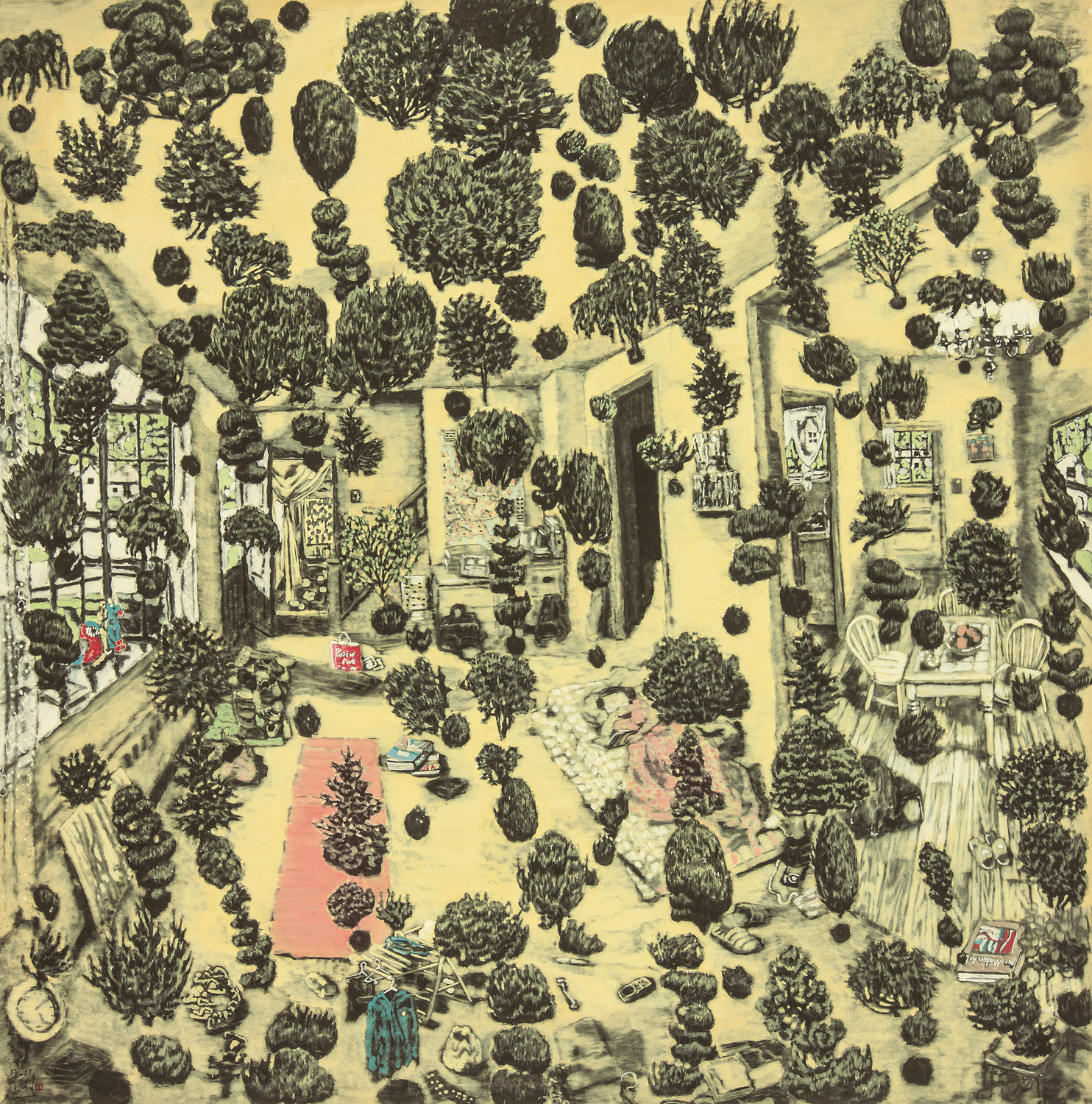 자라는 실내(Growing Room), 2011, 한지에 수묵채색, 141x138cm
자라는 실내(Growing Room), 2011, 한지에 수묵채색, 141x138cm 자라는 실내(Growing Room), 2011, 한지에 수묵채색, 199x195cm
자라는 실내(Growing Room), 2011, 한지에 수묵채색, 199x195cm 어떤 만찬(Some dinner), 2007, 한지에 수묵채색, 206x193cm
어떤 만찬(Some dinner), 2007, 한지에 수묵채색, 206x193cm 여행, 2010, 한지에 수묵채색, 74x256cm
여행, 2010, 한지에 수묵채색, 74x256cm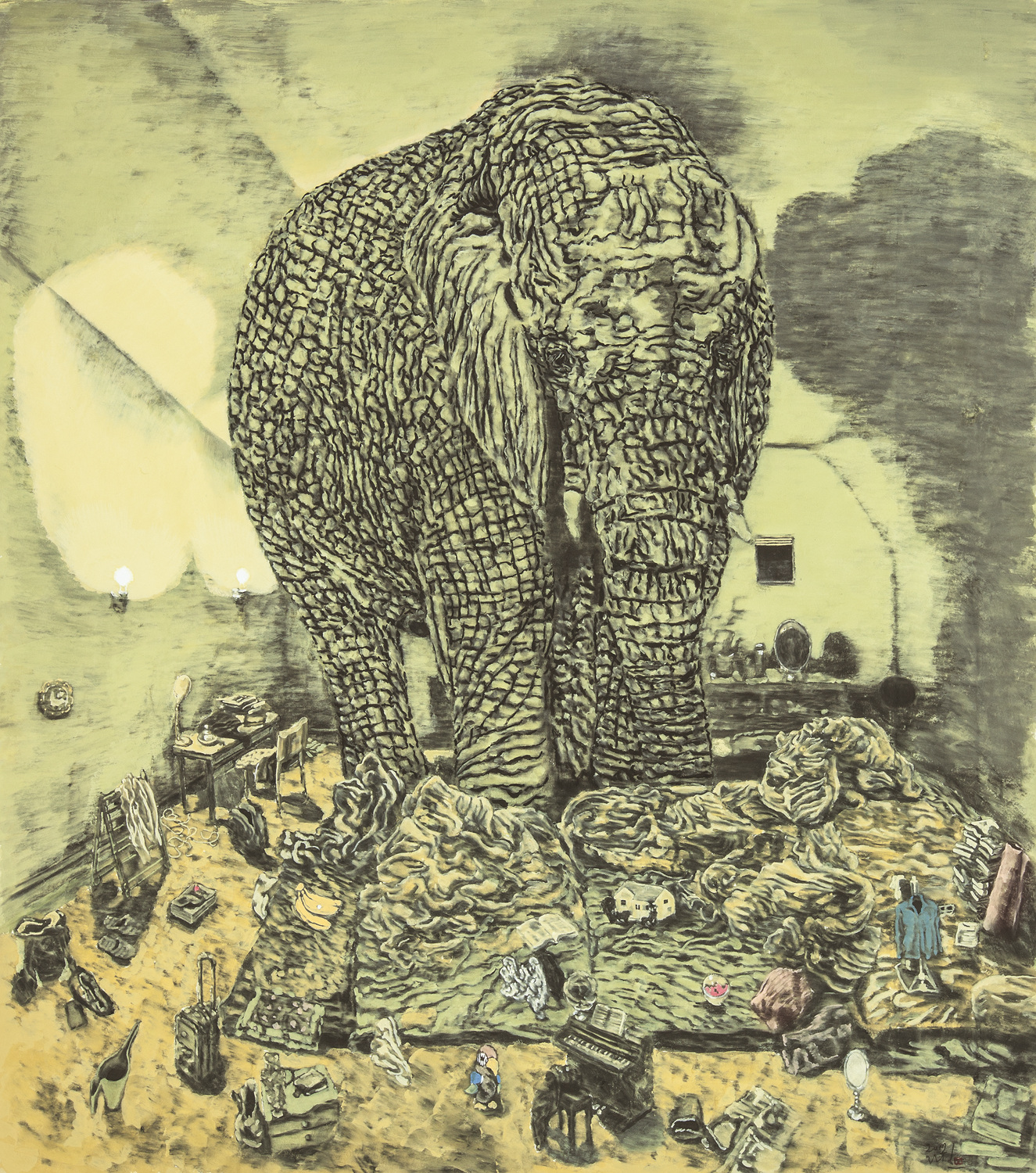 코끼리(Old Giant), 2012, 한지에 수묵채색, 145x138cm
코끼리(Old Giant), 2012, 한지에 수묵채색, 145x138cm
 자라는 실내(Growing Room), 2011, 한지에 수묵채색, 141x138cm
자라는 실내(Growing Room), 2011, 한지에 수묵채색, 141x138cm 자라는 실내(Growing Room), 2011, 한지에 수묵채색, 199x195cm
자라는 실내(Growing Room), 2011, 한지에 수묵채색, 199x195cm 어떤 만찬(Some dinner), 2007, 한지에 수묵채색, 206x193cm
어떤 만찬(Some dinner), 2007, 한지에 수묵채색, 206x193cm 여행, 2010, 한지에 수묵채색, 74x256cm
여행, 2010, 한지에 수묵채색, 74x256cm 코끼리(Old Giant), 2012, 한지에 수묵채색, 145x138cm
코끼리(Old Giant), 2012, 한지에 수묵채색, 145x138cm

